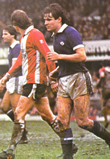Historical Football Kits Updates 2009
Contributions from visitors as well as my own continuing research mean that new material is being added to the archive all the time. Here is a month by month summary of additions, corrections and updates to the site.
30 December: Thanks to Bernard Gallagher and John Lerwill, I have reviewed the evidence to hand and arrived at what I think is the most likely sequence of Aston Villa kits between 1885 and 1887, including the curious "piebald" shirt. Given the difficulty of corroborating scarce source material, the entries remain somewhat provisional.
Liverpool (change kits from 1909-11, 1912, 1929-35 added).
2009-10 updates: Ipswich Town (3rd), Peterborough United (charity strip), Hartlepool United (3rd).
 23 December: The recent derby game between Charlton Athletic and Millwall was dedicated to the memories of the late Rob Knox and Jimmy Mizen, both fans of the Addicks and the Lions, who were murdered in separate street attacks last May. Their families were on the pitch before kick-off to promote the Street Violence Ruins Lives campaign. Both teams wore the campaign logos on their shirts, which carried the names of the victims on the back. The match worn shirts were then auctioned off with proceeds going to the Rob Knox Memorial Fund and the Jimmy Mizen Foundation. These strips are now recorded in the current League One season gallery.
23 December: The recent derby game between Charlton Athletic and Millwall was dedicated to the memories of the late Rob Knox and Jimmy Mizen, both fans of the Addicks and the Lions, who were murdered in separate street attacks last May. Their families were on the pitch before kick-off to promote the Street Violence Ruins Lives campaign. Both teams wore the campaign logos on their shirts, which carried the names of the victims on the back. The match worn shirts were then auctioned off with proceeds going to the Rob Knox Memorial Fund and the Jimmy Mizen Foundation. These strips are now recorded in the current League One season gallery.
Everton (1954 change kit added), Liverpool (1906-07 change added), Sunderland (1996-97 badge detailing amended).
22 December: We have more from Bernard Gallagher who has written to share some of his own research, published earlier in Claret & Blue magazine, which gives further details of Aston Villa's early kits as well as clarifying the club's origins. The reference to blue and red stripes (1876-77) first came from the Birmingham County Football Association handbook of the time. Until I suggested otherwise, everyone presumed that the reference to stripes meant vertical stripes. I suggested and 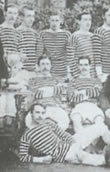 illustrated otherwise in the Claret & Blue magazine some years ago after discovering a reference to Jack Hughes (who claims to have scored Villa’s first ever goal) took part in an athletic meeting in September 1876 wearing a blue and red hooped jersey.
illustrated otherwise in the Claret & Blue magazine some years ago after discovering a reference to Jack Hughes (who claims to have scored Villa’s first ever goal) took part in an athletic meeting in September 1876 wearing a blue and red hooped jersey.
It seems that the black tops surfaced for season 1878-79, with the lion motif. The top was not a jersey but a loose fitting, blouse style shirt with collar. There is photo evidence of this. For season 1879-80 the switch was made to black woollen jerseys. The green strip was also my discovery and is listed in the Aston Villa minute book of the time. Again someone has presumed that “two shades of green” must mean hoops. Wrong. The shirts, not jerseys, were quartered. I have photo evidence of this.
Bernard goes on to provide some intriguing information on the shirts worn in 1885-86: Piebald is not stripes but random blotches. This style was popular with some teams, but not with Villa because the team was not successful when wearing the jersey. The piebald was red on white background. This appears to be at odds with the details provided by the club's historian, John Lerwill so we will seek further confirmation.
The photograph shows the Villa team in June 1882 wearing navy and white, one of many various coloured outfits worn before claret and light blue was adopted in 1887.
18 December: We have more on Rangers shirts from the Victorian period today from Gary Ralston, author of Rangers 1872, The Gallant Pioneers. Gary writes: Firstly, the idea of the Oxford and Cambridge link being my theory is 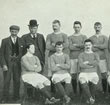 erroneous. As stated in the book, it was suggested by former Rangers player Archibald Steel in his autobiography from the early 1890s, '25 Years Football' (under the nom de plume of 'Old International'). He makes (for me a compelling) argument that Rangers became the 'Light Blues' because Vale of Leven worse such dark blue in two of the three games from the 1877 Scottish Cup final they resembled the colours of Oxford. Now I know I'm getting really precious(!) but I find it quite insulting (I know, I know, I shouldn't really) that I would somehow write about the formation of Rangers in such an in-depth manner and not know the basis from which the club (and indeed other Scottish clubs) were formed. I know our game developed out of the working classes (although Queen's Park, in fairness, were a solidly middle class and 'posh' outfit) and not the universities.
erroneous. As stated in the book, it was suggested by former Rangers player Archibald Steel in his autobiography from the early 1890s, '25 Years Football' (under the nom de plume of 'Old International'). He makes (for me a compelling) argument that Rangers became the 'Light Blues' because Vale of Leven worse such dark blue in two of the three games from the 1877 Scottish Cup final they resembled the colours of Oxford. Now I know I'm getting really precious(!) but I find it quite insulting (I know, I know, I shouldn't really) that I would somehow write about the formation of Rangers in such an in-depth manner and not know the basis from which the club (and indeed other Scottish clubs) were formed. I know our game developed out of the working classes (although Queen's Park, in fairness, were a solidly middle class and 'posh' outfit) and not the universities.
In addition, your assertion of the term 'royal blue' in relation to the crown might be worth a discussion (the Marquis of Lorne, son-in-law to Queen Victoria was the club's first honorary patron). However, quite how you manage to assert a relationship between Rangers of the 1870s and 1880s with unionism is, quite frankly, off the scale for anyone who knows the early history of the club. It seems strange that a website with such a hard earned reputation for its fastidious research would in turn, go public with a theory it admits itself it has no evidence to support.
Anyway, rant over - and I hope you have a great festive season.
13 December: We recently heard from Paul Szyman, who has followed Wolves since the early seventies, a period (Paul writes) when shirt designs were simple, templates few and
suppliers even fewer. A relatively minor design change at  the start of a new
season smacked you between the eyes & embedded itself in your memory. Thanks to Paul we have clarified several dates, identified a warm weather strip (1973-74) and added the strip worn after the team won the League Cup in March 1974 (Photo courtesy of wolvesheroes.com). Paul adds, Around
1977 I played for a youth club side in the Heath Town area of Wolverhampton.
This side had somehow managed to acquire a full set of long sleeved Wolves
shirts from the club (the 1972-late 74 version.) The shirts were
very faded by this time but I am convinced they were genuine. The single
wolf badge was embroidered onto the shirts. Replica shirts of that era didn't
go as far as featuring club badges & when they did appear a little later
they were of the printed variety which cracked & peeled off after a few
washes. I had the pleasure of wearing John McAlle's no 6 shirt. I always
remember how heavy it felt compared to the schoolboy kit I was used to
wearing. I also remember reading the label which told me the shirt was made
of polyamide which I believe to be a form of nylon.
the start of a new
season smacked you between the eyes & embedded itself in your memory. Thanks to Paul we have clarified several dates, identified a warm weather strip (1973-74) and added the strip worn after the team won the League Cup in March 1974 (Photo courtesy of wolvesheroes.com). Paul adds, Around
1977 I played for a youth club side in the Heath Town area of Wolverhampton.
This side had somehow managed to acquire a full set of long sleeved Wolves
shirts from the club (the 1972-late 74 version.) The shirts were
very faded by this time but I am convinced they were genuine. The single
wolf badge was embroidered onto the shirts. Replica shirts of that era didn't
go as far as featuring club badges & when they did appear a little later
they were of the printed variety which cracked & peeled off after a few
washes. I had the pleasure of wearing John McAlle's no 6 shirt. I always
remember how heavy it felt compared to the schoolboy kit I was used to
wearing. I also remember reading the label which told me the shirt was made
of polyamide which I believe to be a form of nylon.
Several kits have been added to the Iconic Away Kits section: Portsmouth (1984-85), Luton Town (1982-83), Spurs (1977-80), Celtic (1982-83), Rangers (1982-84), Derby County (1987-89). The variant kit worn when Leeds United played Dinamo Zagreb in August 1967 has been added due to its historical interest.
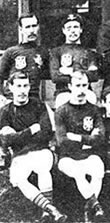 12 December: Our featured photograph of the Scottish Cup winning Dumbarton team from 1883 (4 December) prompted Jim Jenkinson to undertake some research into the badges worn by several players. They are not, as we supposed the crests of the Irish and Dunbartonshire FAs (the latter was not formed until the following year) but Jim's research does shed light on the practice of players sewing crests from representative games onto their club shirts. Jim writes:
12 December: Our featured photograph of the Scottish Cup winning Dumbarton team from 1883 (4 December) prompted Jim Jenkinson to undertake some research into the badges worn by several players. They are not, as we supposed the crests of the Irish and Dunbartonshire FAs (the latter was not formed until the following year) but Jim's research does shed light on the practice of players sewing crests from representative games onto their club shirts. Jim writes:
Jock Hutchison (standing extreme left) was one of several players who played for the 'Scottish Counties' team. This representative team, judging by the clubs supplying players, was representing the whole central belt in Scotland save Glasgow. In January 1883, they played three matches, v Glasgow, v Lancashire and v Birmingham. Hutchison and the man next to him, James McAulay (goalkeeper), the man sitting third from right, James Miller (forward), all played in the matches against Glasgow and Birmingham. The two men sitting on the far left were both called Robert Brown. Newspapers of the day called them (1) and (2) or senior and junior. The club differentiated the two by calling them "Sparrow" and "Plumber", (one being small, the other by his vocation in the shipyards in Dumbarton.) "Plumber" is wearing a badge and played for the Scottish Counties against Lancashire. Joe Lindsay (reclining below the cup) has two badges - but did not play for Scottish Counties that season, but he was selected the season before against Glasgow and Lancashire. This fact combined with no badges on James Miller's shirt, would seem to suggest the badges were from the previous season, (Messrs Hutchison, McAulay, Miller badges fits in with this, but I think it was "Sparrow" and not "Plumber" who played for Scottish Counties in 1881-82.) All I can suggest is that the badges are the Glasgow, Birmingham and Lancashire FAs, awarded in 1882 and 1883.
10 December: The white strip worn by Bury recently has now been confirmed by Ralph Pomeroy to have been a special edition charity strip rather than a new third kit as we stated on 7 December.
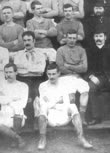 7 December: Our thanks go to Rob Bruce who sent in this fascinating photograph of Rangers taken in February 1887 on the occasion of a match between the current Rangers and a team of former players. The "Moderns" beat the "Ancients" 3-2 in the last game to be played at Kinning Park before the club moved into the first Ibrox stadium. There are several intriguing details.
7 December: Our thanks go to Rob Bruce who sent in this fascinating photograph of Rangers taken in February 1887 on the occasion of a match between the current Rangers and a team of former players. The "Moderns" beat the "Ancients" 3-2 in the last game to be played at Kinning Park before the club moved into the first Ibrox stadium. There are several intriguing details.
First of all we appear to have the entire playing staff, the former players and the entire committee in the picture. Only ten players (presumably the "Ancients") are wearing white shirts. I wonder if the gent sitting on the far right of the second row might be the Ancients' goalkeeper? If so, it suggests that the practice of having goalkeepers wear contrasting tops to their team mates was adopted more than twenty years before the Football League in England made this compulsory.
Rob speculates that the white shirts may have been Rangers' change shirts of the period. While they probably would have worn white when forced to change, I think the shirts worn by the Ancients are in fact the players' own, every day wear (several are sporting neckties). Contrast these with the plain blue shirts worn by the majority of the players with crew necks and three-button fly. This was a very common design in Scotland, widely produced by local gents' outfitters for football teams. As a professional team, I suspect that Rangers would have complete sets of both blue and white tops for their teams while the Ancients (now playing as amateurs) provided their own kit for this game.
Updates: Darlington (1982-84 sponsorship confirmed), Bury (new third strip added).
 4 December: Today's featured team is Dumbarton FC, shown here wearing their navy jerseys of the period with the Scottish FA Cup in 1883 in a photograph submitted by Chris Whitefield. Of particular interest are the various badges sewn onto the players' tops. These would have been removed from shirts worn in representative games (the player standing on the extreme left appears to have both the Ireland and Dunbartonshire FA crests on his jersey). The club adopted their now traditional gold and black in 1888, a year before they merged with Dumbarton Athletic, but the old navy tops reappeared between 1897 and 1904.
4 December: Today's featured team is Dumbarton FC, shown here wearing their navy jerseys of the period with the Scottish FA Cup in 1883 in a photograph submitted by Chris Whitefield. Of particular interest are the various badges sewn onto the players' tops. These would have been removed from shirts worn in representative games (the player standing on the extreme left appears to have both the Ireland and Dunbartonshire FA crests on his jersey). The club adopted their now traditional gold and black in 1888, a year before they merged with Dumbarton Athletic, but the old navy tops reappeared between 1897 and 1904.
From time to time teams are forced to borrow a strip from their oppnents when, for whatever reason, they turn up without a suitable kit. The latest example occured on 2 December when Leyton Orient lent Gillingham their black away strip after the Gills' kit hamper was held up in traffic on the way to the game. Full details are available on Orient's Website. Thanks to Chris Matterface for this snippet.
Huddersfield Town's away kit from the early 1990s has been added to the Iconic Away Kits section. Arsenal (1967-69 socks amended).
1 December: Aston Villa (1993-95 away kit socks corrected), Manchester United (1945-46 added, 1930-31, 1937-38 away kits added and a number of dates revised (thanks to Paul and Tim at unitedkits.com. Swindon Town (new third kit added).
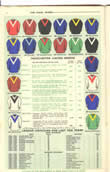 28 November: Tony O'Connor recently contacted HFK, having aquired a rare copy of Umbro's catalogue from 1935 and, with his kind permission we are reproducing a couple of pages. Intriguingly, the bold V style shirts shown on the left are presented as the Manchester United range, despite the fact that the club had dropped this style in 1927 in favour of their more
28 November: Tony O'Connor recently contacted HFK, having aquired a rare copy of Umbro's catalogue from 1935 and, with his kind permission we are reproducing a couple of pages. Intriguingly, the bold V style shirts shown on the left are presented as the Manchester United range, despite the fact that the club had dropped this style in 1927 in favour of their more 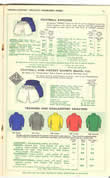 traditional plain red shirts. Each shirt was available in a number of different styles ranging from the Nipper ("suitable for junior clubs" at 25/- (£1.25) per dozen in adult sizes) to the formidable Bulldog ("Tenacious British quality, extra heavy and strongly reinforced. A jersey that does not belie its name" at 93/6d (£4.65) per dozen).
traditional plain red shirts. Each shirt was available in a number of different styles ranging from the Nipper ("suitable for junior clubs" at 25/- (£1.25) per dozen in adult sizes) to the formidable Bulldog ("Tenacious British quality, extra heavy and strongly reinforced. A jersey that does not belie its name" at 93/6d (£4.65) per dozen).
Knickers were available in white, navy or black only (other colours did not appear until the mid-fifties) and are also offered in a number of different quality finishes, the best being the Ironclad, which are "guaranteed untearable," setting back the club treasurer by 41/- a dozen (£2.05). All knickers included Umbro's Fricshunfree velvet crutch "as used at Wembley." 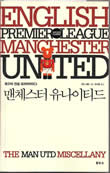 Priceless.
Priceless.
HFK is pleased to be associated with the publication of two new books, now on the shelves ready for Christmas and for which we have provided artwork. The Dundee United Official Centenary History by Peter Rundo & Mike Watson (Birlinn 2009 ISBN 978 1 84158 828 5) is a comprehensive and beautifully presented history of Dundee United while The Vision Book of Football Records by Clive Batty (Vision Sports Publishing 2009 ISBN 978 1905326 68 6) is a generously illustrated general encyclopedia of the game. One you won't find in your local Waterstone's is this Korean edition of VSP's Manchester United Miscellany for which we were delighted to provide the artwork.
Updates: Oxford United (2001 Aug-Sept added, 1984-85, 2000-01, 2009-10 modified). Dundee Harp have been added to the Eminent Victorians section. Brechin City (1909-10 added), Montrose (1910-11 added), Albion Rovers (1912-13 added), St Bernard's (1920-21, 1921-22 added), Raith Rovers (1930-31 amended), Berwick Rangers (1959-60 added), Dundee Hibernian (1909-1922 shirts are now the correct dark green), Dundee United (1924-25, 1936-37, 1957-58, 1972-73 added).
24 November: New Bournemouth third strip added. The crests worn in a number of FA Cup Finals have been amended: Tottenham Hotspur (1921), Huddersfield Town (1922), Bolton Wanderers (1923), Blackpool (1953), Preston North End (1954). Fulham (1959-60 socks amended). The 1948-49 Manchester United strip with hooped stockings has now been identified as their blue and white change kit. Arsenal 1957-58 change kit added.
22 November: I recently received this from Robert Bruce, who runs the Rangers FC History website.
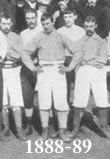 It has always been debated as to why Rangers were called the “Light Blues” In a club history which appeared in the SFA annual of 1894 ‘Obo’ claimed Rangers had been known as the light blues for the 22 years of their existence as a result of the colour of their shirts.... Rangers were always listed as blue and after 1879 royal blue (in SFA records). Some have argued that Rangers were given the nickname light blues not because of the colour of the shirt but because of the dash of performers. At around the time of the 1877 Scottish Cup Final The Glasgow News called the team the “Light and Speedy Rangers”. It would be easy to see why the name light blues could come from. Gary Ralston author of Rangers-The Gallant Pioneers writes that Rangers may have been given the nickname because during the 1877 Scottish Cup final Vale of Leven wore Dark Blue almost Black shirts and Rangers the more traditional blue. He writes that the moniker light blue should be considered in the context of the
It has always been debated as to why Rangers were called the “Light Blues” In a club history which appeared in the SFA annual of 1894 ‘Obo’ claimed Rangers had been known as the light blues for the 22 years of their existence as a result of the colour of their shirts.... Rangers were always listed as blue and after 1879 royal blue (in SFA records). Some have argued that Rangers were given the nickname light blues not because of the colour of the shirt but because of the dash of performers. At around the time of the 1877 Scottish Cup Final The Glasgow News called the team the “Light and Speedy Rangers”. It would be easy to see why the name light blues could come from. Gary Ralston author of Rangers-The Gallant Pioneers writes that Rangers may have been given the nickname because during the 1877 Scottish Cup final Vale of Leven wore Dark Blue almost Black shirts and Rangers the more traditional blue. He writes that the moniker light blue should be considered in the context of the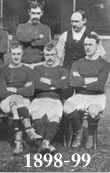 tradition of Oxford and Cambridge Universities. Vale being similar to Oxford and Rangers in a hue of kit not as powerful resembled the Light Blues of Cambridge. Of course we will never know for sure but I go with the Oxford Cambridge link myself. Also worth mentioning is that Rangers were probably kitted out by the company H & P McNeil “Hatters, Hosiers, Clothiers and Shirt Makers” this was a Glasgow company who were owned by brothers Peter (Rangers) and Harry (Rangers/Queens Park).
tradition of Oxford and Cambridge Universities. Vale being similar to Oxford and Rangers in a hue of kit not as powerful resembled the Light Blues of Cambridge. Of course we will never know for sure but I go with the Oxford Cambridge link myself. Also worth mentioning is that Rangers were probably kitted out by the company H & P McNeil “Hatters, Hosiers, Clothiers and Shirt Makers” this was a Glasgow company who were owned by brothers Peter (Rangers) and Harry (Rangers/Queens Park).
Some time ago HFK was commissioned by Vision Sports Publishing to produce the artwork for their Rangers Miscellany and the historian advising them told me that the pre-1921 shirts should be a similar light blue to that worn by Manchester City and Marseilles. Last year we were 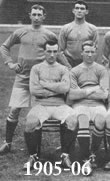 commissioned by the club to produce a poster of all their previous kits (it's in the trophy room at Ibrox). I had the colour as a lightish blue until 1921 but the club's official historian insisted that, as the shirts were consistently described as "royal blue" in the official records, I change these. However, the more photographs that I study the more convinced I am that the term "royal blue" was a misnomer and that they were in fact a lightish mid-blue ("saxe blue"): certainly they were not the very pale Cambridge blue associated with, say, Blackburn Rovers in the late 18th century.
commissioned by the club to produce a poster of all their previous kits (it's in the trophy room at Ibrox). I had the colour as a lightish blue until 1921 but the club's official historian insisted that, as the shirts were consistently described as "royal blue" in the official records, I change these. However, the more photographs that I study the more convinced I am that the term "royal blue" was a misnomer and that they were in fact a lightish mid-blue ("saxe blue"): certainly they were not the very pale Cambridge blue associated with, say, Blackburn Rovers in the late 18th century. 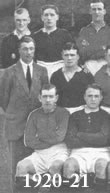 Judging by some of the photographs shown here, the shirts started out as a fairly deep blue and faded over time.
Judging by some of the photographs shown here, the shirts started out as a fairly deep blue and faded over time.
There is some inconsistency in the SFA records, according to our research associate Alick Milne, who has cited examples of "blue" being used to describe "navy blue," "light blue" for "mid-blue." We ascribe this to the fact that the most popular colour for Scottish clubs in those days was navy blue. This suggests that Rangers' nickname of "Light Blues" was meant to distinguish them from the many teams that wore navy blue at the time.
I am not sure about Gary Ralston's theory of a connection with Oxford and Cambridge. In England, certainly, there are many examples of teams adopting one or both of these colours because founder members had an association with the universities and there are many other examples of  teams taking the colours of the public schools where their founders were pupils. In Scotland, however, the game did not develop out of the public schools and universities and was taken up by the working class rather earlier than in England. The priority would have been for straightforward designs that were inexpensive for the players to buy (until professionalism was permitted in 1893, players had to provide their own kit). This, I think, explains why plain navy, maroon and white shirts/jerseys were commonplace.
teams taking the colours of the public schools where their founders were pupils. In Scotland, however, the game did not develop out of the public schools and universities and was taken up by the working class rather earlier than in England. The priority would have been for straightforward designs that were inexpensive for the players to buy (until professionalism was permitted in 1893, players had to provide their own kit). This, I think, explains why plain navy, maroon and white shirts/jerseys were commonplace.
It occurs to me that the term "royal" blue may have been adopted to reflect the club's association with unionism and, by extension, the Crown but I have no evidence to support this.
There is a fine collection of Rangers team photographs on this MySpace page.
21 November: Our good friends at Toffs have made available a limited edition medal to commemorate the late Sir![]() Bobby Robson. A donation of 50p from each sale goes to the Sir Bobby Robson Foundation to help continue the fight against cancer. To order yours, just click on the Toffs link on the right.
Bobby Robson. A donation of 50p from each sale goes to the Sir Bobby Robson Foundation to help continue the fight against cancer. To order yours, just click on the Toffs link on the right.
Accrington Stanley have introduced a new home strip, which will be worn for the first time on 24 November. The remarkable special edition kit worn recently by Dundee United in their friendly with Dundee has been added to the current SPL gallery..
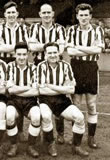 16 November: We're grateful to Christopher Worrall & Begoña Hernandez who have been researching Dunfermline Athletic's strips for HFK and uncovered a good deal of new material. (1932-34, 1962-64, 1973-74 added; 1896-1901, 1921-22, 1934-38, 1938-48, 1948-50, 1958-60, 1960-61, 1961-62, 1964-68, 1974-76, August 1977, 1986-88, 2005-06, 2007-08 amended). The photograph shows the Pars team of 1957-58, the last season that they wore their traditional 2" striped shirts before switching to candy stripes. By this stage clubs were wearing the new lightweight "continental" style shirts with V necks and short sleeves but in Scotland, the old-fashioned cotton drill shirts were retained for winter use, as shown here.
16 November: We're grateful to Christopher Worrall & Begoña Hernandez who have been researching Dunfermline Athletic's strips for HFK and uncovered a good deal of new material. (1932-34, 1962-64, 1973-74 added; 1896-1901, 1921-22, 1934-38, 1938-48, 1948-50, 1958-60, 1960-61, 1961-62, 1964-68, 1974-76, August 1977, 1986-88, 2005-06, 2007-08 amended). The photograph shows the Pars team of 1957-58, the last season that they wore their traditional 2" striped shirts before switching to candy stripes. By this stage clubs were wearing the new lightweight "continental" style shirts with V necks and short sleeves but in Scotland, the old-fashioned cotton drill shirts were retained for winter use, as shown here.
15 November: Falkirk (1985-86 corrected, 1982-85, 1986-88 logos added), East Stirlingshire (1993-94, 1998-99, 1999-2000 corrected), Brighton & Hove Albion (Sept 1958-59, 1966-68, Jan-May 1970 added), the Manchester United strip worn in the 1909 FA Cup final now has an authentic crest,
14 November: Halifax Town (1948-49 added), Chelsea (1973-74, 1974-75 amended), Greenock Morton have dropped their red away kit because of poor quality and are using last season's away and third kits instead.
6 November: Because of the immense amount of historical material submitted by visitors and added to HFK over the last 18 months, our older English and Scottish season galleries have been neglected. As a result a lot of broken links, ghost files and incorrect graphics have found their way into these sections. I've now updated them all, improved the internal links and replaced those presented in older formats. These sections are provided to show a snapshot of the English and Scottish leagues at significant points in their development, show how kits evolved over time and display the diversity (or lack of it) of team strips. Updated galleries are marked in red. Please mind the step as you enter.
Falkirk (1998-99 added).
4 November: Stirling Albion (1984-85 shorts and socks now confirmed).
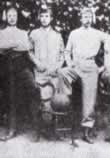 3 November: I stated in yesterday's item on the evolution of striped shirts that vertical stripes appeared for the first time around 1884. This prompted David Rice to dig out this fantastic photograph of Forest FC (the team that became the famous Wanderers) from 1863. Inevitably, the players are wearing vertically striped shirts. The pattern is extremely narrow and resembles the traditional tops worn at Harrow School, where the game is still played under the original Harrow Rules.
3 November: I stated in yesterday's item on the evolution of striped shirts that vertical stripes appeared for the first time around 1884. This prompted David Rice to dig out this fantastic photograph of Forest FC (the team that became the famous Wanderers) from 1863. Inevitably, the players are wearing vertically striped shirts. The pattern is extremely narrow and resembles the traditional tops worn at Harrow School, where the game is still played under the original Harrow Rules.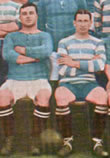
This picture of Rangers FC from 1909 (right) has been sent in by Davie Thomson and illustrates a number of interesting points. The reserves are wearing the team's change colours and I recall seeing Rangers team groups, with both home and change strips, until the late 1960s at least. The image is one of a series of colourised pictures made at the time. While these can be misleading, I do think that the lightish shade of mid-blue shown here is reasonably accurate. Although the club's records described their shirts as royal blue, every photograph I have seen suggests that they were considerably lighter, at least until the early 1920s.
Other updates: Kilmarnock (new third strip added), Dunfermline Athletic (1983-84 restored), Albion Rovers (1988-89, 1989-90 amended), Berwick Rangers (1979-80 detailing added), Forfar Athletic (new away kit added), Bristol City (1983-86 collar detailing amended).
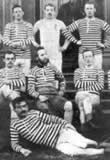 2 November: This morning I thought we would have a look at how vertically striped shirts evolved in the nineteenth century. Of all the many designs that have appeared over the years, vertical stripes are most closely identified with association football but they did not appear until 1884 or thereabouts. Previously the term "striped" referred to the horizontally striped jerseys worn here by Darwen in 1879. This design was extremely popular in the
2 November: This morning I thought we would have a look at how vertically striped shirts evolved in the nineteenth century. Of all the many designs that have appeared over the years, vertical stripes are most closely identified with association football but they did not appear until 1884 or thereabouts. Previously the term "striped" referred to the horizontally striped jerseys worn here by Darwen in 1879. This design was extremely popular in the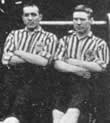 1870s and early 1880s and was the most common style combining two colours.
1870s and early 1880s and was the most common style combining two colours.
The earliest reference we have come across to vertical stripes describes Burnley wearing them in 1884. Although we have no photograph of this particular strip, it is likely to have been similar to that worn by the club in 1888-89 (right). The garment is a proper shirt (made from flannel or woven cotton with a buttoned collar) while the earlier jerseys were made from wool or knitted cotton. Incidentally the crest worn by the team 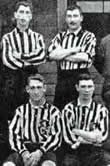 consists of the Prince of Wales' feathers and commemorates the visit of Prince Edward to Turf Moor in 1886. Club crests were rarely worn although emblems, such as the Maltese cross, stars or lettering did appear.
consists of the Prince of Wales' feathers and commemorates the visit of Prince Edward to Turf Moor in 1886. Club crests were rarely worn although emblems, such as the Maltese cross, stars or lettering did appear.
The narrow stripes must have been hard to make out from a distance on gloomy winter afternoons so as professionalism took hold and attendances grew, new styles were introduced that were easier to see. The intermediate stripes worn by New Brompton in 1894 (left) were typical of the period but are still less broad than their modern counterparts. Here again we see a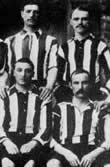 crest but only one player is wearing it. On close examination it appears to include a white horse, the emblem of Kent, which suggests it is the badge of the Kent County FA. At this time players picked for their county or country often cut the badge off their representative top and had it sewn on to their club shirt.
crest but only one player is wearing it. On close examination it appears to include a white horse, the emblem of Kent, which suggests it is the badge of the Kent County FA. At this time players picked for their county or country often cut the badge off their representative top and had it sewn on to their club shirt.
The Notts County team that won the FA Cup in 1894 wore stripes that were unusually wide for the period but this style became more popular after the turn of the century when the other styles fell out of favour. A point of interest on these shirts is how much variation there is in the way the stripes are centred. Clearly the fabric was cut from bolts of fabric that had the stripes dyed into it with no attempt to match up the pattern on each shirt. This kind of variation can also be seen on striped shirts in the first 20-30 years of the 20th century but became less common as production techniques improved.
 1 November: Our photograph today shows Tottenham Hotspur playing Bury in an FA Cup tie in February 1901. Spurs are weariing the striped shirts, their change kit at the time. Note that the goalkeeper, who has just punched the ball away despite the fact that no opposition players are near him, is wearing the same shirt as the outfield players (click on the thumbnail to see the entire image). It was not until 1909 that the rules were changed to require goalkeepers to wear distinctive tops so that referees could distinguish them in a scrum of players.
1 November: Our photograph today shows Tottenham Hotspur playing Bury in an FA Cup tie in February 1901. Spurs are weariing the striped shirts, their change kit at the time. Note that the goalkeeper, who has just punched the ball away despite the fact that no opposition players are near him, is wearing the same shirt as the outfield players (click on the thumbnail to see the entire image). It was not until 1909 that the rules were changed to require goalkeepers to wear distinctive tops so that referees could distinguish them in a scrum of players.
Other updates: Bournemouth & Boscombe Athletic (1928-29 added), Huddersfield Town (1969-70 amended), Clyde (1990-91 add), Dunfermline Athletic (1983-85 added, various detailing added to strips 1980-1999). Peterhead's new third kit and Livingston's change kit have been added.
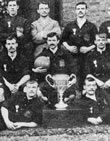 30 October: Quite what Thames Ironworks wore in 1899-1900 has engaged the attention of John Powles (author of Iron in the Blood and Irons of the South), Grant Hole and Tim Conlan, all of whom have been in touch this week. Grant and Tim have been combing through the newspaper archives and their conclusion, which is supported by John, is that they wore light blue shirts, white knickers and vermilion socks throughout, with white shirts when a change was needed. Quite where this leaves Jack Helliar's information (see 21 October) is unclear. The photograph shows the Irons in 1896.
30 October: Quite what Thames Ironworks wore in 1899-1900 has engaged the attention of John Powles (author of Iron in the Blood and Irons of the South), Grant Hole and Tim Conlan, all of whom have been in touch this week. Grant and Tim have been combing through the newspaper archives and their conclusion, which is supported by John, is that they wore light blue shirts, white knickers and vermilion socks throughout, with white shirts when a change was needed. Quite where this leaves Jack Helliar's information (see 21 October) is unclear. The photograph shows the Irons in 1896.
Kidderminster Harriers (1976-77 added), Boston United (1993-95 added), Chester City (1998-99 shorts detailing added), East Stirlingshire (slight variations worn 1983-87 added, 2004-05, Aug 1998 added, one- off January 2008 added), Kilmarnock (1994-95, 1995-96 corrected), Ross County (1987-91 shorts and socks now confirmed).
29 October: As Christmas approaches we can expect a rash of third kits to be launched: Fulham have introduced a limited edition home shirt to mark their 130th anniversary as well as a smart third strip.
Other updates: Halifax Town (1993-94 detailing added), Morecambe (1994-95, 1997-98, 1998-99, 1999-2000 added).
28 October: Bukta have now lost three of their four contracts with Scottish clubs after complaints about late delivery and poor quality. The clubs all took the unusual step of seeking permission from the SFL to change their registered kits, which suggests that the sportswear company were unable to staisfy the clubs that these issues could be resolved. The world's oldest sportswear brand now face a very hard struggle to regain the confidence of customers in an extremely competitive market. Details of the new Pendle kits for Forfar Athletic (H), Arbroath (H & A) and Brechin City (H & A) have been posted today. Greenock Morton have withdrawn replicas of their red away Bukta strip because of problems with colour-fastness.
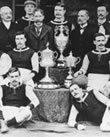 27 October: I have been unhappy with the early section of the Aston Villa gallery for some time. Many of the references I've used are confusing, contradictory or maddeningly vague so yesterday I wrote to John Lerwill, the club's official historian to see if he could help. I was delighted to receive John's reply first thing this morning, which included a detailed list of Villa's colours up to 1924 along with primary sources. This has allowed me to complete a thorough review of the period 1876-1894 and add several previously unrecorded strips. John has recently published The Aston Villa Chronicles (1874-1924) and details are available on his website.
27 October: I have been unhappy with the early section of the Aston Villa gallery for some time. Many of the references I've used are confusing, contradictory or maddeningly vague so yesterday I wrote to John Lerwill, the club's official historian to see if he could help. I was delighted to receive John's reply first thing this morning, which included a detailed list of Villa's colours up to 1924 along with primary sources. This has allowed me to complete a thorough review of the period 1876-1894 and add several previously unrecorded strips. John has recently published The Aston Villa Chronicles (1874-1924) and details are available on his website.
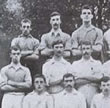 25 October: Research continues into the Thames Ironworks kit of 1899-1900. Grant Hole has established that this photograph from the Spartacus Educational site was taken during that season and speculates that the description provided by Jack Helliar (see 21 October) refers to their normal colours of red socks, white knickers and light blue shirts, as worn in the picture. This implies that Cambridge blue knickers were adopted sometime after the picture was taken. We hope that further information will come to light and in the meantime the 1899-1900 graphic has been amended in line with Grant's suggestion.
25 October: Research continues into the Thames Ironworks kit of 1899-1900. Grant Hole has established that this photograph from the Spartacus Educational site was taken during that season and speculates that the description provided by Jack Helliar (see 21 October) refers to their normal colours of red socks, white knickers and light blue shirts, as worn in the picture. This implies that Cambridge blue knickers were adopted sometime after the picture was taken. We hope that further information will come to light and in the meantime the 1899-1900 graphic has been amended in line with Grant's suggestion.
Stoke City (1974-75, 1976-77 alternate kits added), Everton (2009-10 charity kit added), Wolverhampton Wanderers (late 1973-74 added, 1976-79, 1979-82, 1982-83, 1982-85, late 1985 detailing amended), Norwich City (1939-40 added), Aston Villa (1945-46 change added), Airdrieonians (1995-97 detailing added), Aldershot Town (1997-98, 2002-04 corrected), Port Vale (1989-90, 1990-91 maker's logo added).
Paul Nagel has confirmed that, according to the Manchester Evening News of August 1903, the turnover on Manchester United's socks had a blue rather than red band.
Bukta, the world's oldest sportswear manufacturer, are having a bad season. Following the decision by Arbroath to switch to another supplier because Bukta failed to deliver replicas on time, Greenock Morton have announced that they are withdrawing their replica red away kits from sale due to their poor quality.
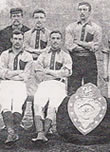 22 October: As we noted on 13 October, Small Heath's new royal blue shirts were not delivered in time for the opening of the 1890-91 season and the team had to wear their old gold-trimmed black tops for the first few games. After losing out on promotion in the end-of-season test matches in 1893, they changed again for the following season, this time into pale blue and navy shirts. These did the trick and, after finishing as runners-up, the beat Darwen in their test match to win promotion to the First Division. The photograph shows the team before their opening game against Rotherham Town, resplendent in their brand new shirts. The giant figure standing behind the shield wearing dark knickers is the Heathen's 6' 5" goalkeeper, George Hollis.
22 October: As we noted on 13 October, Small Heath's new royal blue shirts were not delivered in time for the opening of the 1890-91 season and the team had to wear their old gold-trimmed black tops for the first few games. After losing out on promotion in the end-of-season test matches in 1893, they changed again for the following season, this time into pale blue and navy shirts. These did the trick and, after finishing as runners-up, the beat Darwen in their test match to win promotion to the First Division. The photograph shows the team before their opening game against Rotherham Town, resplendent in their brand new shirts. The giant figure standing behind the shield wearing dark knickers is the Heathen's 6' 5" goalkeeper, George Hollis.
Other updates: Dunfermline Athletic (1990-92 collar and crest amended), Chelsea (1929-33, 1933-38, 1958-59 added; 1922-23, 1936-37 change kits added).
Do pay a visit to unitedkits.com, a comprehensive season-by-season guide to Manchester United's kits with a wealth of supporting detail, put together by regular HFK contributors, Paul Nagel and Tim Ashmore.
21 October: The detective work recently undertaken by several contributors into the early colours of Thames Ironworks/West Ham United has been given a further twist following an article by Jack Helliar, the Hammers' 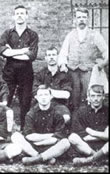 historian, in the Hammers Monthly Vol 1 No 2 which states: On March 10 1900, there were 10,000 fans at the Memorial Grounds for the visit of Sp*rs in a Southern League game. The 0-7 reverse earlier in the season was avenged in as much that the Works forced a goal-less draw, despite Syd Kig breaking an ankle that kept him out of action until the October of the following season. Records of the period now disclose that the Iron Works colours were red, white and blue, with Cambridge blue shorts. The final league match of the season at Canning Town was played April 17 1900, Sheppey United being defeated 4-2. This is intriguing not least because the design of the shirts is not described (we have taken an educated guess) but also because it was exceedingly rare for teams to play in anything other than white, navy or black knickers at this time. My thanks to Kevin Courtney for drawing this to our attention.
historian, in the Hammers Monthly Vol 1 No 2 which states: On March 10 1900, there were 10,000 fans at the Memorial Grounds for the visit of Sp*rs in a Southern League game. The 0-7 reverse earlier in the season was avenged in as much that the Works forced a goal-less draw, despite Syd Kig breaking an ankle that kept him out of action until the October of the following season. Records of the period now disclose that the Iron Works colours were red, white and blue, with Cambridge blue shorts. The final league match of the season at Canning Town was played April 17 1900, Sheppey United being defeated 4-2. This is intriguing not least because the design of the shirts is not described (we have taken an educated guess) but also because it was exceedingly rare for teams to play in anything other than white, navy or black knickers at this time. My thanks to Kevin Courtney for drawing this to our attention.
The photograph is of the Ironworks team in 1895, wearing their original colours of Harrovian Blue.
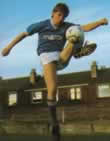 In recent weeks, Donald Gellatly has been scouring old programmes and SFL Handbooks to fill in the gaps in our records for the smaller Scottish clubs in the 1980s. For his outstanding contribution we are happy to award Donald the accolade of HFK Research Associate. His latest submission includes Meadowbank Thistle (1982-83 added, 1983-84 socks corrected), Arbroath (1989-90 added), Ayr United (1983-84 added), Berwick Rangers (1988-89), Raith Rovers (1984-85 - see photograph left, 1987-88 added, 1985-86 sponsor corrected).
In recent weeks, Donald Gellatly has been scouring old programmes and SFL Handbooks to fill in the gaps in our records for the smaller Scottish clubs in the 1980s. For his outstanding contribution we are happy to award Donald the accolade of HFK Research Associate. His latest submission includes Meadowbank Thistle (1982-83 added, 1983-84 socks corrected), Arbroath (1989-90 added), Ayr United (1983-84 added), Berwick Rangers (1988-89), Raith Rovers (1984-85 - see photograph left, 1987-88 added, 1985-86 sponsor corrected).
Thanks to Ian Fleming, we have been able to add further detail to the East Stirlingshire section: (1983-87, 1987-88, 1993-94, 1994-95, 1995-96, 1999-2000, 2007-08 amended). You can view Ian's collection shirts at My Shire Tops.
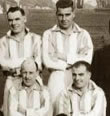 20 October: Today's photograph is of the Brighton & Hove Albion team from 1934-35 wearing their typical lightish blue and white stripes. The Football Encyclopedia of 1934 (Associated Sporting Press) records the team's shirts as "red, white and blue stripes" but so far, HFK has been unable to corroborate this. A number of previously unrecorded Brighton strips have been added, for the most part minor variations of collars and stockings: (1909-10, 1912-14, 1944-45, 1946-47, Aug-Sept 1962, Jan-March 1972, Dec 1972-March 1973, March-May 1973, Sept 1973-March 1974 added).
20 October: Today's photograph is of the Brighton & Hove Albion team from 1934-35 wearing their typical lightish blue and white stripes. The Football Encyclopedia of 1934 (Associated Sporting Press) records the team's shirts as "red, white and blue stripes" but so far, HFK has been unable to corroborate this. A number of previously unrecorded Brighton strips have been added, for the most part minor variations of collars and stockings: (1909-10, 1912-14, 1944-45, 1946-47, Aug-Sept 1962, Jan-March 1972, Dec 1972-March 1973, March-May 1973, Sept 1973-March 1974 added).
We have a few additions to our Iconic Away Kits section today: Luton Town (1976-77), Aston Villa (1983), Brighton & Hove Albion (1983-84), Doncaster Rovers (1984-87), Chelsea (1983-84).
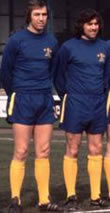 18 October: Northern Ireland's strip worn against the Czech Republic last week has been added to the International Section.
18 October: Northern Ireland's strip worn against the Czech Republic last week has been added to the International Section.
As regular visitors will know, HFK disapproves of the proliferation of variant kits currently in vogue, driven largely by the insistence of match officials that all elements of team strips contrast with their opponents. Interestingly, this is not always the case in the English Premier League where, for example, both Arsenal and Everton wore their normal home strips (with white shorts) earlier this season. Frankly if these strips were considered sufficiently different to be acceptable, we don't see why Liverpool should have had to wear gold shorts with their black away kit when they played Sunderland recently. We will, however, continue to post variants where they are of historical interest and in this vein we present these images of Chelsea from 1972. The first shows the team in their League Cup final kit when they adopted gold trim to the shorts and gold socks to contrast with Stoke City's white shorts and socks. (A similar outfit had been worn two years earlier in the FA Cup Final replay with Leeds United). Later in the same season, the Blues wore a variation on this 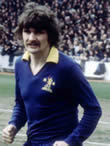 strip with yellow collars and trim on the shorts in four league matches. We believe this is one of the first examples of a team wearing a variant strip on a regular basis.
strip with yellow collars and trim on the shorts in four league matches. We believe this is one of the first examples of a team wearing a variant strip on a regular basis.
The practice of changing shorts and socks (but not shirts) appears to have begun much earlier on the international stage. When England resumed playing international matches after the Second World War their first choice socks were navy blue but red was worn against opponents with navy, black or blue socks, a practice that continues to the present.
Other updates: Partick Thistle (1984-86, 1986-87, 1987-89 maker's logos added), Dunfermline Athletic (1981-83 badge added, 1983-86 amended), Arbroath (1984-86, 1986-88 amended), Alloa Athletic (1992-94 corrected).
16 October: Montrose (1983-84 added), Arbroath (1980-84 logos added), Partick Thistle (1983-84 added), Cowdenbeath (1983-84 added), Stenhousemuir (1983-84 added). In addition a large number of dates have been amended for minor Scottish clubs between 1980 and 1985.
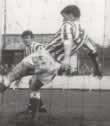 15 October: Generally speaking, Macclesfield Town have worn plain blue shirts throughout their history. However, we recently posted their 1973-74 kit, which was identical to the famous Birmingham City "penguin top" and we can now add this striped shirt worn in 1969-70. Thanks to Richard Young for this latest contribution.
15 October: Generally speaking, Macclesfield Town have worn plain blue shirts throughout their history. However, we recently posted their 1973-74 kit, which was identical to the famous Birmingham City "penguin top" and we can now add this striped shirt worn in 1969-70. Thanks to Richard Young for this latest contribution.
Huddersfield Town (1969-70 badge corrected), Dunfermline Athletic (1988-89 sponsorship corrected), Wycombe Wanderers (2009-10 3rd kit added), Hereford United (1946-47, circa 1962 added), Heart of Midlothian (1983-84), Dumbarton (1978-81, 1983-84 added), Brechin City (1982-84 maker's logos added), East Stirlingshire (1979-82 logos added), Dunfermline Athletic (1981-83 logos added), Stirling Albion (1980-81 logos added), Cowdenbeath (1981-82 corrected, 1982-84 added), East Fife (1980-82 added), Alloa Athletic (1981-82 added).
14 October: Today we have Donald Gellatly's latest offerings. Montrose (1981-84 added, 1984-86 corrected, 1988-Feb 1989, Feb 1989-1990 dates amended, 1986-88 logos added); Queen of the South (1987-89 logos added), Alloa Athletic (1986-87 logos, 1987-88 added), Stirling Albion (1984-85 added, 1985-88 logos), Brechin City (1984-85, 1985-88 logos), Dumbarton (1984-87 sponsorship added, 1987-89 logos), East Stirlingshire (1983-87 logos), Stenhousemuir (1984-85 combined badge and sponsorship added, 1985-86 correct sponsor applied, 1988-89 added), Cowdenbeath (1984-86 corrected), Meadowbank Thistle (1985-86 added).
The kit worn by England in the Ukraine on Saturday has been added.
13 October: HFK understands that Arbroath FC are about the register new home and away strips  from a different supplier following the failure of Bukta to supply replica versions. This cutting from Kjell Henson is from the Birmingham Daily Post of September 15, 1890 and reveals that problems with suppliers are not just a modern phenomenon. (Click the thumbnail to see an enlarged version.)
from a different supplier following the failure of Bukta to supply replica versions. This cutting from Kjell Henson is from the Birmingham Daily Post of September 15, 1890 and reveals that problems with suppliers are not just a modern phenomenon. (Click the thumbnail to see an enlarged version.)
Stoke City (1975-76 alternate added); Albion Rovers (1989-90 added); Cowdenbeath (1987-88, 1988-89 sponsorship added, 1993-94 logos added); Dumbarton (1989-90 added); East Stirlingshire (1987-88, 1988-89, 1999-2001 missing detailing added); Montrose (1988-90 corrected); Stenhousemuir (1987-88 added); Stranraer (1988-90 logos added).
2009-10 updates: Rangers (3rd added), Doncaster Rovers (3rd added), Cambridge United (new sponsor added).
6 October: Hibernian (2009-10 3rd kit added), Burton Albion (1972-73 added), Cambridge United (1960-61 socks details added), Macclesfield Town (1973-74 added).
5 October: Chelsea (1956-57 added), Middlesbrough (1981-82 added), Arsenal (1959-60 alternate change kit added), Darlington (1888 added, 1889 revised), Everton (1946-47 away kit added), Bolton Wanderers (1952-53 added) and from Donald Gellatly Queen's Park (1984-88 maker's logos added), Cowdenbeath (1990-91 added), Dumbarton (1990-91 added), Stenhousemuir (1986-87 logos added, 1990-91 added), East Stirlingshire (1993-94, 1994-95, 1995-96, 1996-97, 1997-98, 1998-99 added; 1990-91 logos added).
2009-10 updates: East Stirlingshire (sponsors added).
4 October: More from Donald Gellatly and an excuse to encourage you to visit some of our more obscure galleries - Alloa Athletic (1997-98, 1998-99 makers' logos added), Ayr United (1996-97 logos added, dates for 1997-98 and 1998-99 confirmed), Berwick Rangers (1994-95, 1995-96 logos added, 1993-95, 1999-2000 now correctly dated), Elgin City (2000-03 dates amended), Inverness Caledonian Thistle (1995-96 logos added), Peterhead (1997-2000 added), Queen's Park (1995-97 shirt sponsor corrected, 1997-98 added), Stenhousemuir (several manufacturers identified), East Stirlingshire (1999-2000 logos added), Ross County (1993-94, 1994-95 logos added), Stirling Albion (1995-96, 1996-98, 1998-99 logos added), Queen of the South (1997-98 logos added).
3 October: Scotland (1881 amended, 1935, 1937, 1950 added): Sheffield Wednesday (late 1961-62, early 1962-63 kits now presented in the correct order): Burton Albion (1974-75, 1975-76, 1995-96 added): Darlington (1889 added):
2009-10 Additions & Updates: Rochdale (new sponsor's logo added), Peterhead (A added), Cardiff City (latest sponsor added), Hamilton Academical (3rd added).
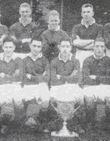 27 September: Discovering new material about the obscure clubs that have played in the English and Scottish leagues in the past is always exciting so I am grateful to John Small for sending in this picture of Galston FC from 1935-36 with the Scottish Qualifying Cup. This was the only route through which non-league teams could qualify for the Scottish FA Cup until it was abolished in 2007. Galston were members of the ill-fated Scottish Third Division before resigning in 1925, a decision that helped bring about the collapse of that competition a few weeks later.
27 September: Discovering new material about the obscure clubs that have played in the English and Scottish leagues in the past is always exciting so I am grateful to John Small for sending in this picture of Galston FC from 1935-36 with the Scottish Qualifying Cup. This was the only route through which non-league teams could qualify for the Scottish FA Cup until it was abolished in 2007. Galston were members of the ill-fated Scottish Third Division before resigning in 1925, a decision that helped bring about the collapse of that competition a few weeks later.
Darlington (1957-58, 1965-66 added, 1982-84 corrected). Donald Gellatly continues to make a valuable contribution, filling in the gaps in our records for minor Scottish clubs in the 1990s. Todays selection includes Albion Rovers (1994-96 added, 1996-98 corrected, 1998-2000, 2000-01, 2001-02 manufacturers' logos added), Brechin City (1990-92 added, 1994-95 corrected), Montrose (1997-98 added), Raith Rovers (1998-99 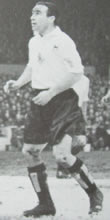 socks now correct), Clydebank (1997-98, 1998-99 socks now correct), Alloa Athletic (1994-95 socks corrected), Ross County (1995-96 corrected), Peterhead (2000-01 added, 2001-02, 2002-04 manufacturers' logos added).
socks now correct), Clydebank (1997-98, 1998-99 socks now correct), Alloa Athletic (1994-95 socks corrected), Ross County (1995-96 corrected), Peterhead (2000-01 added, 2001-02, 2002-04 manufacturers' logos added).
The second photograph presented today is of Sir Alf Ramsey turning out for Tottenham Hotspur against Blackpool on a snow-bound pitch in February 1955. Of interest are the striped stocking turnovers, a style that enjoyed a vogue in the late-50s and early-60s and of which this may be the earliest example. We are not sure if these socks were worn during the rest of the 1954-55 season. Thanks go to Tony Sealey for this image and for details of a special edition kit that the team wore in two FA Cup ties in 1934.
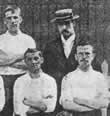 26 September: On 27 August we featured an item about how different authorities disagreed over the date that Tottenham Hotspur adopted their familiar white shirts. The issue now seems to have been settled by the club's historian, Andy Porter, who provides us with a copy of an article printed in The Golden Penny from 17 September 1898 that includes this photograph of the team in white shirts and navy blue knickerbockers. By clicking on the thumbnail on the left you can view the complete article.
26 September: On 27 August we featured an item about how different authorities disagreed over the date that Tottenham Hotspur adopted their familiar white shirts. The issue now seems to have been settled by the club's historian, Andy Porter, who provides us with a copy of an article printed in The Golden Penny from 17 September 1898 that includes this photograph of the team in white shirts and navy blue knickerbockers. By clicking on the thumbnail on the left you can view the complete article.
Other updates: Alloa Athletic (1995-96 added and dates 1988-95 amended), Stirling Albion (1991-93 manufacturer's logos added), Berwick Rangers (1991-93 dates confirmed), Albion Rovers (1992-94 dates confirmed), Stranraer (1990-1993 dates confirmed), Brechin City (1991-94 dates confirmed), Meadowbank Thistle (1990-91 added), Queen's Park (1990-92 dates confirmed), Stenhousemuir (1991-93 dates confirmed), Wimbledon Old Centrals (1896-97 added), Partick Thistle (2009-10 special edition), Third Lanark (1966-67 added).
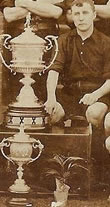 25 September: If you recognise today's featured team or the trophies in the picture please let me know. It was probably taken in 1894-95 or shortly afterwards. A nice touch is the placement of pot plants to add interest to the composition. These are still in their wrappers which carry the legend (?)oseland Florist.
25 September: If you recognise today's featured team or the trophies in the picture please let me know. It was probably taken in 1894-95 or shortly afterwards. A nice touch is the placement of pot plants to add interest to the composition. These are still in their wrappers which carry the legend (?)oseland Florist.
Birmingham City (1956 FA Cup Final amended).
2009-10 additions: Republic of Ireland (3rd), Shrewsbury Town (3rd), MK Dons (3rd), Lincoln City (3rd), Millwall (3rd), Leeds United (3rd). The proliferation of alternate shorts and socks is taking up far too much time and space on the site and compromises our ability to undertake other projects. As a result we will no longer post graphics of variants of Home, Away and Third kits unless they are of historical interest. In this category we include the special edition shirts to be worn in tomorrow's game between Ipswich Town and Newcastle United, which will be auctioned off after the match with proceeds going to the Sir Bobby Robson Foundation.
13 September: Dumbarton (1996-98, 1998-99 added), Montrose (1994-95 added), Raith Rovers (1998-99 added), Stranraer (1998-99 added), Hamilton Academical (1984-85 alternate kit added), Albion Rovers (2009-10 away kit 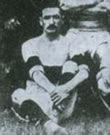 corrected), Airdrie United (2009-10 home amended, away kit added).
corrected), Airdrie United (2009-10 home amended, away kit added).
A little while ago we revised the West Ham United kits between 1900 and 1903 after new research confirmed that their colours at the time were light blue and claret rather than pink and black. Grant Hole has now written with a theory about how the confusion may have arisen: Coincidentally both Thames Ironworks FC and South West Ham FC were formed in 1895. (The Ironworks team) played in the London League at Hermit Road and wore Oxford blue, later pale blue, white and scarlet. South West Ham played in the South Essex league close to the now non existent Tidal Basin railway station which was just West of Royal Victoria station a stones throw from the ironworks. South West Ham were called 'The Pinks (or) Pink Uns' - we don't know why but there must be a very good chance that they wore pink kit. It is perhaps not surprising that when Thames Ironworks changed their name to West 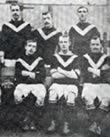 Ham United in 1900 there was some confusion because of the similarity of name especially as the two grounds were no more than a mile and a half apart.
Ham United in 1900 there was some confusion because of the similarity of name especially as the two grounds were no more than a mile and a half apart.
This little treasure comes from Simon Monks' collection and is a rare picture of Burton United taken in 1906-07 when the team wore brown and light blue tops. There is no connection with the modern Burton Albion. (Incidentally, if you can fill in any gaps in our records for the modern club, please get in touch.)
Derby County (1890-91, 1893-94 corrected). Scotland (1886, 1893 added: new evidence suggests that the national team wore a thistle crest between 1872 and 1898.)
![]() 11 September: The little snippet shown here has been sent in by David Rice, and is the caption from the photograph we discussed on 5 September and serves to deepen the mystery surrounding it. The caption, which has become detached from the picture identifies the team as being The Wednesday although according to Andrew Drake the player line up is from a Sheffield FA representative match. We may never know the truth of the matter so the graphic remains in our Sheffield Wednesday section with a caveat.
11 September: The little snippet shown here has been sent in by David Rice, and is the caption from the photograph we discussed on 5 September and serves to deepen the mystery surrounding it. The caption, which has become detached from the picture identifies the team as being The Wednesday although according to Andrew Drake the player line up is from a Sheffield FA representative match. We may never know the truth of the matter so the graphic remains in our Sheffield Wednesday section with a caveat.
Updates: Wimbledon (1963-64, 1966-97, 1967-70, 1970-73, 1973-74, Aug-Dec 1974, 1976-77, 1985-86 added; 1929-52 badge corrected.)
2009-10 additions: Arsenal (2009-10 A alt), Millwall (A updated), Livingston (new H), Notts County (H alt, A), Cardiff City (sponsorship added).
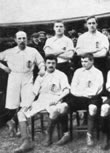 8 September: When England met Scotland for the first ever international fixture in 1872, the players wore white shirts and knickerbockers, which remained their strip for the rest of the decade. Quite when the FA adopted navy knickers is a bit of a mystery (we believe it was around 1882) but this photograph, from Clive Nicholson's collection, gives us an intriquing clue. Taken in 1897, it clearly shows that some players are wearing white knickers while others are in dark ones. We can infer from this that the FA required players to provide their own knickers and socks but did not stipulate what colour these should be. Clive has also provided a picture of a rare Scotland jersey from 1899, which has been added to the archive.
8 September: When England met Scotland for the first ever international fixture in 1872, the players wore white shirts and knickerbockers, which remained their strip for the rest of the decade. Quite when the FA adopted navy knickers is a bit of a mystery (we believe it was around 1882) but this photograph, from Clive Nicholson's collection, gives us an intriquing clue. Taken in 1897, it clearly shows that some players are wearing white knickers while others are in dark ones. We can infer from this that the FA required players to provide their own knickers and socks but did not stipulate what colour these should be. Clive has also provided a picture of a rare Scotland jersey from 1899, which has been added to the archive.
For reasons that escape me, and despite having introduced perfectly good home and away kits for this season, Carlisle United have turned out twice in last season's black away kit and against Leyton Orient, they 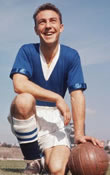 wore white, last season's third strip.
wore white, last season's third strip.
I had thought that the satin trim on the Scotland shirt featured on 2 September was unique but true to form, Simon Monks has dug into his personal collection to send us this picture of the great Jimmy Greaves in his Chelsea strip from 1957-58, which has, as we can see, blue satin cuffs.
Other updates: Dumbarton (2002-04 collar detailing amended and kit now attributed to Vandanel), Clydebank (1997-98, 1998-99 added), Arbroath (1994-95, 1995-97, 1997-98 added; 1986-87 dates amended), Brechin City (1994-95 added), Ross County (1994-95 added; 1996-98 socks confirmed).
5 Sept 2009-10 additions: Sunderland (3rd), Rotherham United (H alt), Northampton Town (H alt), Colchester United (3rd). Alasdair Gibbs-Barton has written to HFK on the subject of proliferating kits: This is just a moan, not aimed at you or your site in any way, but at the powers that be in football today, and the subject is alternate kits, especially alternate home kits. What is the point of these? If your team is at home you have first choice of kit. If you are away, and your first choice kit clashes, you play in your away kit. It should be simple! But nowadays some teams have 5 or 6 kits, home & alternate, away & alternate, even third & alternate. Actually, if you are lucky enough to be in a European competition, it goes on with yet more! I suppose the answer must be down to commercialism..... Well said Alasdair; here at HFK we couldn't agree more.
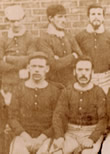 Some time ago we featured the photograph on the left, taken in 1875, and attributed it to The Wednesday. We've now heard from Andrew Drake, an authority on the club, who writes: I have a terrible inkling that the 1874-5 kit isn't Wednesday at all. The picture is included in "Romancing the Wednesday", the 1926 biography of Wednesday by Richard Sparling - however the names of the players are from the Sheffield F.A. v. Birmingham F.A. match on Saturday 20th November 1875. The match was played as a benefit for the Sheffield Football Players Accident Society. Sheffield won 6-0. Wednesday were the pre-eminent club in the Sheffield area at the time and so provided most of the team. (Sheffield F.C. had given up playing against local teams by this point, and so when they did play, tended to play London Rules, rather than Sheffield Rules - and nobody was terribly interested except for the occasional F.A. Cup match.) All of the players mentioned had represented Wednesday at least once during the 75-76 season (though not during the 74-75 season) However they were never in the team at the same time and at least 4 of the players were not Wednesday regulars. At this time players tended to play for their club on most Saturdays but if a big out of town match occured they would happily switch allegiance, so Wilkinson only played against Clydesdale, Bowling against Derby, and England against Thurlstone Crystal Palace (a village just outside Barnsley). The Sheffield F.A. teams wore red shirts. The player in the bottom right hand corner of the picture, Jack Hunter, was playing for Wednesday during the 75-76 season and may well be wearing a Wednesday shirt in the picture (dark and white hoops - could be blue and white). You can visit Andrew's site at SWFC History.
Some time ago we featured the photograph on the left, taken in 1875, and attributed it to The Wednesday. We've now heard from Andrew Drake, an authority on the club, who writes: I have a terrible inkling that the 1874-5 kit isn't Wednesday at all. The picture is included in "Romancing the Wednesday", the 1926 biography of Wednesday by Richard Sparling - however the names of the players are from the Sheffield F.A. v. Birmingham F.A. match on Saturday 20th November 1875. The match was played as a benefit for the Sheffield Football Players Accident Society. Sheffield won 6-0. Wednesday were the pre-eminent club in the Sheffield area at the time and so provided most of the team. (Sheffield F.C. had given up playing against local teams by this point, and so when they did play, tended to play London Rules, rather than Sheffield Rules - and nobody was terribly interested except for the occasional F.A. Cup match.) All of the players mentioned had represented Wednesday at least once during the 75-76 season (though not during the 74-75 season) However they were never in the team at the same time and at least 4 of the players were not Wednesday regulars. At this time players tended to play for their club on most Saturdays but if a big out of town match occured they would happily switch allegiance, so Wilkinson only played against Clydesdale, Bowling against Derby, and England against Thurlstone Crystal Palace (a village just outside Barnsley). The Sheffield F.A. teams wore red shirts. The player in the bottom right hand corner of the picture, Jack Hunter, was playing for Wednesday during the 75-76 season and may well be wearing a Wednesday shirt in the picture (dark and white hoops - could be blue and white). You can visit Andrew's site at SWFC History.
Other updates: Ayr United (1995-96 added), Ross County (1996-98 added), Cowdenbeath (1993-94, 1994-95, 1996-98, 1998-2000, 2003-04 added). We have Donald Gellatly to thanks for these and other modern Scottish additions added recently.
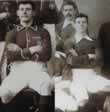 2 September: Today's featured photographs are of the Scottish national side and come from Clive Nicholson. On the left is the 1894 side wearing splendid shirts with satin collars and cuffs, edged in white: the cuffs are of an unusual, military style. The image on the right (which I believe shows the same player) is from 1898 and features a very large, white collar. Note also that the thistle crest worn in 1894 has been replaced by the red and gold lion rampant in 1898.
2 September: Today's featured photographs are of the Scottish national side and come from Clive Nicholson. On the left is the 1894 side wearing splendid shirts with satin collars and cuffs, edged in white: the cuffs are of an unusual, military style. The image on the right (which I believe shows the same player) is from 1898 and features a very large, white collar. Note also that the thistle crest worn in 1894 has been replaced by the red and gold lion rampant in 1898.
Staying with the Scottish theme, the history of Johnstone FC has been revised. Thanks to the research of Brian McColl we now know that there were two clubs with this name: the first was formed in 1878 and disappeared in 1887 while the second, which went on to play in the Scottish Football League, came into existence in 1891. There is no connection between the two.
Other updates: Brechin City (1995-96, 1996-97 added); Stenhousemuir (2002-03 added and some dates between 1995 and 2003 amended).
31 August: Brechin City (1998-99 added, 1999-2001 now correctly dated); Arbroath (1998-99 added, 1999-2000 now correctly dated);
2009-10 additions: Huddersfield Town (H alt & A alt added, away kit sponsor corrected)
30 August: Motherwell (1947-48 added); Montrose (1996-98, 1998-99 added); Stenhousemuir (1996-98 added).
2009-10 additions: Bristol City (H alt), Manchester City (3rd).
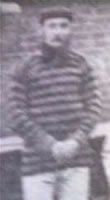 29 August: We have David Rice to thank for tracking down today's photograph, a remarkable early team picture of Notts County from 1870, which appears courtesy of the Football Nostalgia website. This confirms information we have previously only been able to access from secondary written sources, that the team's earliest colours were amber and black "stripes," which is to say one-inch horizontal hoops with plain crew necks. This was typical of the earliest multi-coloured jerseys that emerged around this time when teams started to wear uniform tops as inter-club matches became popular. Previously, players wore whatever they had to hand and teams were distinguished by coloured scarves and caps.
29 August: We have David Rice to thank for tracking down today's photograph, a remarkable early team picture of Notts County from 1870, which appears courtesy of the Football Nostalgia website. This confirms information we have previously only been able to access from secondary written sources, that the team's earliest colours were amber and black "stripes," which is to say one-inch horizontal hoops with plain crew necks. This was typical of the earliest multi-coloured jerseys that emerged around this time when teams started to wear uniform tops as inter-club matches became popular. Previously, players wore whatever they had to hand and teams were distinguished by coloured scarves and caps.
Other updates: Newcastle United (1901-02 added); Sunderland (1906-07 added); Preston North End (1904-05 added); Thornhill United (1901-02 added); Rotherham Town (1901-02 added); Burton United (1904-05 amended). These are all sourced from early newsreel footage preserved by the British Film Institute. Links can be found in each club section and have also been posted in the Bradford City, Gainsborough Trinity, Wolverhampton Wanderers, Aston Villa, Bolton Wanderers, Everton and Liverpool galleries where you can view original footage, courtesy of Youtube. Thanks to Kjell Hanssen for pointing out this resource.
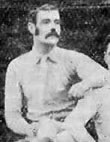 27 August: Today we feature more information about Tottenham Hotspur's early kits. The first picture, submitted by Jonathon Russell shows the 1885 team wearing the Cambridge blue and white shirts they adopted after watching Blackburn Rovers win the FA Cup. I have enhanced the contrast in the thumbnail to show detail of the Maltese cross worn on the left breast, a popular motif at the time. (Click the thumb to see the full team photograph.)
27 August: Today we feature more information about Tottenham Hotspur's early kits. The first picture, submitted by Jonathon Russell shows the 1885 team wearing the Cambridge blue and white shirts they adopted after watching Blackburn Rovers win the FA Cup. I have enhanced the contrast in the thumbnail to show detail of the Maltese cross worn on the left breast, a popular motif at the time. (Click the thumb to see the full team photograph.)
The second was taken in 1897 when the team wore chocolate and old gold and is a rather better picture than the one we featured on 15 August. According to Andy Porter, Spurs' official historian, the knickers were also dark brown, an unusual feature at a time when knickers were usually black, navy or white. Andy also informs Jonathon that the team generally wore broad navy and blue hoops when colours clashed between 1908 and the 1940s.
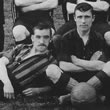 We have also heard from Tony Sealey who provides two sources (Spurs. A History of Tottenham Hotspur, Julian Holland 1956 and Tottenham Hotspur: An Illustrated History, Bob Goodwin 1995) that state that the team adopted white shirts in September 1899 rather than 1898 as given on the club's website. A third source, (From And the Spurs Go Marching On…….. Phil Soar 1985) gives 1900 as the year the change was made.
We have also heard from Tony Sealey who provides two sources (Spurs. A History of Tottenham Hotspur, Julian Holland 1956 and Tottenham Hotspur: An Illustrated History, Bob Goodwin 1995) that state that the team adopted white shirts in September 1899 rather than 1898 as given on the club's website. A third source, (From And the Spurs Go Marching On…….. Phil Soar 1985) gives 1900 as the year the change was made.
In Victorian times photography was still in its infancy, requiring lengthy exposure times so the action from important games was usually presented in the newspapers by sketches. These were not always a reliable guide to kits and were probably drawn by artists who had not attended the game. An example of this is the drawing shown here of the FA Cup Final of 1893 between Wolves and Everton. Tantalisingly, a 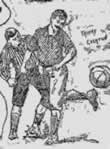 photograph of this match exists on Wikipedia, but the players are too distant to make out any detail. We can however, see that Wolves are wearing a dark strip although the team photograph, taken a few days later, confirms that the stripes are much wider than those in the sketch. Everton are in light shirts and white knickers: their registered colours of the time were ruby shirts and navy knickers but from this evidence it appears that they played in light blue and white for this game, a combination that records suggest did not become their regular colours in 1895.
photograph of this match exists on Wikipedia, but the players are too distant to make out any detail. We can however, see that Wolves are wearing a dark strip although the team photograph, taken a few days later, confirms that the stripes are much wider than those in the sketch. Everton are in light shirts and white knickers: their registered colours of the time were ruby shirts and navy knickers but from this evidence it appears that they played in light blue and white for this game, a combination that records suggest did not become their regular colours in 1895.
2009-10 additions: Arsenal (H alt), Fulham (H alt), Birmingham City (H alt), Manchester United (Champions League kit), Blackburn Rovers (3rd), Cowdenbeath (A), Tranmere Rovers (A), Colchester United (A), Mansfield Town (H), Aldershot Town (3rd).
 25 August: Some weeks ago the assertion that West Ham United wore salmon pink shirts in the early years of the twentieth century was challenged by David Smith and John Northcutt. After a protracted correspondence with David, John and Kevin Slade, who made the original submission, the issue was settled by the club's historian, John Hellier in an article in the club programme this weekend, which provides categorical evidence that the Hammers wore light blue shirts in 1900-01 (their first season) and added a claret band for 1901-1903. The familar claret shirts with light blue sleeves appeared for the first time in 1903 but there is a story that the captain of Thames Ironworks had won a set of Aston Villa tops in a wager in 1899. I am grateful to everyone involved in this piece of detective work and particularly to Kevin Slade who graciously brought the new information to my attention. (Photograph of the 1901-02 team courtesy of Spartacus Educational.)
25 August: Some weeks ago the assertion that West Ham United wore salmon pink shirts in the early years of the twentieth century was challenged by David Smith and John Northcutt. After a protracted correspondence with David, John and Kevin Slade, who made the original submission, the issue was settled by the club's historian, John Hellier in an article in the club programme this weekend, which provides categorical evidence that the Hammers wore light blue shirts in 1900-01 (their first season) and added a claret band for 1901-1903. The familar claret shirts with light blue sleeves appeared for the first time in 1903 but there is a story that the captain of Thames Ironworks had won a set of Aston Villa tops in a wager in 1899. I am grateful to everyone involved in this piece of detective work and particularly to Kevin Slade who graciously brought the new information to my attention. (Photograph of the 1901-02 team courtesy of Spartacus Educational.)
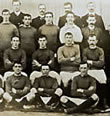 Other updates: Motherwell (1960-62 socks corrected); Macclesfield Town (1906-07, circa 1950 added); Grimsby Town (photos from 1904-05 and 1905-06 (left) confirm that the team wore white rather than black knickers with their salmon pink jerseys); Fulham (1959-60 added); Gainsborough Trinity (1904-05 added); Norwich City (1910-11, 1913-14 added);
Other updates: Motherwell (1960-62 socks corrected); Macclesfield Town (1906-07, circa 1950 added); Grimsby Town (photos from 1904-05 and 1905-06 (left) confirm that the team wore white rather than black knickers with their salmon pink jerseys); Fulham (1959-60 added); Gainsborough Trinity (1904-05 added); Norwich City (1910-11, 1913-14 added);
2009-10 additions: Burnley (H alt), Nottingham Forest (A), Cardiff City (A), Queen's Park Rangers (H alt), Coventry City (H alt), Manchester City (A alt), Manchester United (H alt, Portsmouth (3rd).
24 August: Stirling Albion (1998-99, 1999-2000 added): Rangers (1984-86 socks corrected): Chesterfield (1972-73 alternate kits added): Aston Villa (2007-08 3rd corrected - this was never used but had it been, the kitroom staff have told Caine Pickering that light blue rather than claret shorts would have been worn): Scotland (1985-88 alternate home kit added): Chelsea (1965-67 red change kit added): Blackpool (1910-11 added).
16 August 2009-10 additions: Dagenham & Redbridge (A), Cardiff City (H alt), Brighton (3rd alt), Preston North End (3rd), Torquay United (A), Rotherham United (A), Airdrie United (H alt).
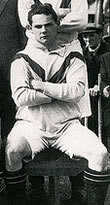 15 August: The United Kits Through the Ages website is developing into a very fine resource with an unsurpassed collection of team photographs including this one of Manchester United in white shirts with a red V from 1922-23. Tim Ashmore, who runs the site speculates that the new look was brought in by John Chapman when he was appointed manager. Chapman's previous club was Airdrieonians who had adopted the same distinctive outfit some ten years earlier under his stewardship. We have been able to add a considerable amount of detail to HFK thanks to Tim's research and that of his collaborator and HFK Research Associate, Paul Nagel. (1902-03, 1903-07, 1912-13, 1913-14, 1914-17, 1924-26, 1925-26, 1926-27 added to the Manchester United Home Section; 1902-03, 1905-06, 1907-08, 1913-14, 1919-20, 1921-22, 1922-23 added to the Manchester United Away Section.)
15 August: The United Kits Through the Ages website is developing into a very fine resource with an unsurpassed collection of team photographs including this one of Manchester United in white shirts with a red V from 1922-23. Tim Ashmore, who runs the site speculates that the new look was brought in by John Chapman when he was appointed manager. Chapman's previous club was Airdrieonians who had adopted the same distinctive outfit some ten years earlier under his stewardship. We have been able to add a considerable amount of detail to HFK thanks to Tim's research and that of his collaborator and HFK Research Associate, Paul Nagel. (1902-03, 1903-07, 1912-13, 1913-14, 1914-17, 1924-26, 1925-26, 1926-27 added to the Manchester United Home Section; 1902-03, 1905-06, 1907-08, 1913-14, 1919-20, 1921-22, 1922-23 added to the Manchester United Away Section.)
Tony Sealey has been browsing old Tottenham Hotspur handbooks that his father collected and has sent HFK fascinating new information. An example is this picture of the team taken in 1896-97 showing the team in the chocolate and gold shirts that they adopted that season after being elected to the Southern League. Although the reproduction is not that good, we can clearly make out that the "gold" 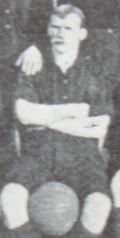 stripes are almost as dark as the chocolate ones, which persuades me that they must have the same sort of deep shade of old gold that Wolves wore around this time. We now know that these striped shirts were retained for use as a change kit after Spurs adopted white shirts in 1898 and worn against visiting teams that wore white (in those days, the home team changed). For good measure we also have Spurs playing in what appear to be chocolate and gold hooped jerseys in January 1901 against a German Select XI who are wearing all-white. (Spurs Home Section: 1896-97 amended, Away Section: 1899-1900, Jan 1901, Feb 1901, 1952-53 FA Cup change, 1961-62 European, 1962-63 European kits added).
stripes are almost as dark as the chocolate ones, which persuades me that they must have the same sort of deep shade of old gold that Wolves wore around this time. We now know that these striped shirts were retained for use as a change kit after Spurs adopted white shirts in 1898 and worn against visiting teams that wore white (in those days, the home team changed). For good measure we also have Spurs playing in what appear to be chocolate and gold hooped jerseys in January 1901 against a German Select XI who are wearing all-white. (Spurs Home Section: 1896-97 amended, Away Section: 1899-1900, Jan 1901, Feb 1901, 1952-53 FA Cup change, 1961-62 European, 1962-63 European kits added).
Tony has also provided evidence that West Bromwich Albion wore white sleeves with their navy and white striped shirts several years earlier than previously thought. (1961-62, 1964-65 added).
HFK Research Associate Geoff Bell has also been busy, contacting Percy Young and Tony Matthews, authorities on Wolverhampton Wanderers who have between them written three definitive histories of the club. With their help we have established that the striped shirts we featured on 19 July were in fact "faded red" and white and not blue and white. Furthermore, we now know that the striped shirts shown in the club page for 1892-93 were in fact worn only in the FA Cup final of that season. (1883-84, 1888-91 corrected, 1891-92 added, 1892-93 FA Cup Final kit corrected).
2009-10 additions: Sheffield United (3rd), Derby County (3rd), Watford (H alt), Motherwell (A).
13 August 2009-10 additions: Northern Ireland (A), Albion Rovers (H, A), Stranraer (H, A corrected), Arbroath (H, A), Dundee (H, A), Hamilton Academical (A), Queen's Park Rangers (3rd), Bristol City (A alt), Brighton (A alt), Brentford (A alt).
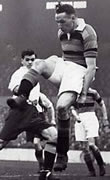 9 August: QPR (1932-33 corrected): Liverpool (1931-32 added): Burnley (1907-08 added): Fulham (1928-29 added): Bradford PA (1948 added - pictured left): Walsall (1938-39 shorts detail added): Norwich City (1936-39 shorts amended): Newport County (1935-38 shorts detail added).
9 August: QPR (1932-33 corrected): Liverpool (1931-32 added): Burnley (1907-08 added): Fulham (1928-29 added): Bradford PA (1948 added - pictured left): Walsall (1938-39 shorts detail added): Norwich City (1936-39 shorts amended): Newport County (1935-38 shorts detail added).
2009-10 additions: Fulham (H alt), Forfar Athletic (A).
8 August: The Scottish Football League's season, which opens today, has descended into farce due to the debacle over Livingston. Yesterday the club's new owners announced they would appeal against the decision to demote them to the Third Division leading the SFL to announce that today's matches involving the three clubs that have been moved to different divisions to be "provisional," meaning that if Livi's appeal is successful, the results will be declared void and the clubs will return to the status quo ante. Furthermore, Livi's management have refused to fulfil today's Third Division fixture with East Stirlingshire on the grounds that while the appeal is outstanding they remain a First Division club. As usual, comprehensive coverage of the developing story can be found in The Scotsman.
2009-10 additions: Cowdenbeath (H), Stranraer (H, A). With the addition of Torquay United (H) we now have all the English home kits posted and we hope to complete the Scottish section over the next few weeks. We'd like to 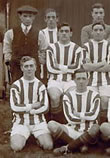 take this opportunity to thank the hundreds of contributors who have alerted us to the new strips as they were released. We also thank the many club officials who have been extremely helpful by providing missing details.
take this opportunity to thank the hundreds of contributors who have alerted us to the new strips as they were released. We also thank the many club officials who have been extremely helpful by providing missing details.
Other updates: Featured on the left is an intriguing picture of Scunthorpe United from 1913-14 that shows the team wearing surprisingly modern looking striped shirts that are very clearly white and either claret or blue. This might be a change kit but we have provisionally added it to the Scunthorpe gallery. Let us know if you can shed light. Aston Villa (1937-38 added): Bolton Wanderers (1938 added): Charlton Athletic (1938 added): Sheffield Wednesday (October 1936 added).
7 August: Chester City will after all play in the Blue Square Conference when the season kicks off tomorrow albeit with a 25-point penalty that will almost certainly see them drop into the Conference North in 2010. The decision was announced following a joint meeting of the Conference and FA, To ease concerns being expressed by those member clubs who are scheduled to play them in the forthcoming weeks, it was felt prudent to release this interim statement at this time. For more details visit The Guardian Online.
Meanwhile, the future of troubled Livingston is once again in doubt following the decision earlier in the week by the SFL to relegate the club from the First to Third Divisions for breaching insolvency rules. This follows the last minute reprieve given to the club on 30 July when the SFL allowed a takeover to go ahead. The new owners have previously stated that they will walk away if the club were to be relegated and the interim manager, Donald McGruther, of 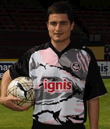 administrators Mazars has warned that they may not be able to survive in the lowest division. Airdrie United move back up to the First Division in their place and Cowdenbeath will now play in the Second. More details are reported in the West Lothian Courier.
administrators Mazars has warned that they may not be able to survive in the lowest division. Airdrie United move back up to the First Division in their place and Cowdenbeath will now play in the Second. More details are reported in the West Lothian Courier.
2009-10 updates: Partick Thistle (A) have once again produced an extraordinary design (left), East Stirlingshire (H), Stenhousemuir (sponsorship added), Stirling Albion (H, A), Montrose (H, A & 3rd), Charlton Athletic (A), Hartlepool United (A), Exeter City (A), Notts County (H).
6 August 2009-10 additions: Derby County (A), Cheltenham Town (A), Ayr United (H, A), Reading (3rd), Rangers (A), Kilmarnock (A).
Several contributors have noticed that Newcastle United have appeared in variously coloured shorts while wearing their new away and third strips in pre-season friendlies. HFK is going to wait to see if any of these are used in the Championship before we add them to the site.
2 August: A feature of HFK is that we benefit from the work of many expert contributors who generously share their research with us. For example, we have today updated our England section with new material provided by Glen Isherwood covering the period 1954 to 1970. Glen is one of the main contributors to the excellent England Football Online site and the authority on England's kits.
Updates: Chelsea (1959-60 socks corrected):
2009-10 additions: Newcastle United (3rd).
1 August: Chester City are facing imminent disaster following their relegation to the Blue Square Conference. According to the Two Hundred Percent website the club's owner, Stephen Vaughan, transferred legal ownership to his son, Stephen Vaughan Junior prior to placing the club in administration over the summer. Under FA 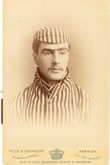 rules anyone who takes a club into administration twice is barred from being a director but owing to the change of ownership, Vaughan Senior will avoid this sanction. As City's main creditor, Vaughan has offered to buy it back from the administrators with a Creditors Voluntary Agreement (CVA) that will offer the other creditors a mere 15p in the pound. It appears that the FA, however, have smelled a rat and they have withdrawn the club's licence. Chester are barred from playing until the concerns of the FA are addressed but have been given dispensation for a friendly against Droylesden this weekend. So far the FA has not specified publicly what their concerns are but if the situation is not resolved before the Conference season starts, the club faces expulsion and liquidation. Updates are available at BBC Sport.
rules anyone who takes a club into administration twice is barred from being a director but owing to the change of ownership, Vaughan Senior will avoid this sanction. As City's main creditor, Vaughan has offered to buy it back from the administrators with a Creditors Voluntary Agreement (CVA) that will offer the other creditors a mere 15p in the pound. It appears that the FA, however, have smelled a rat and they have withdrawn the club's licence. Chester are barred from playing until the concerns of the FA are addressed but have been given dispensation for a friendly against Droylesden this weekend. So far the FA has not specified publicly what their concerns are but if the situation is not resolved before the Conference season starts, the club faces expulsion and liquidation. Updates are available at BBC Sport.
I could not resist posting these cards sent in by Wim Hayes from The Hague, who writes, Through your excellent work I was able to come up with a first clue as to the origin of the uniforms both gentlemen wear. As you have probably spotted right away, the gentlemen are Harrow footballers. Through further research I was able to identify the gentlemen and to 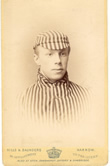 establish that they were both members of the HarrowFootball XI of 1888-1889. Hoare (below) also played for the Harrow Cricket XI and went on to score a 108 n.o. in the Harrow vs. Eton match of 1888.
establish that they were both members of the HarrowFootball XI of 1888-1889. Hoare (below) also played for the Harrow Cricket XI and went on to score a 108 n.o. in the Harrow vs. Eton match of 1888.
2009-10 additions: Plymouth Argyle (A), Boston United (H), Reading (A).
Other updates: Newcastle United (1969 Fairs Cup kit, 1973-74 third kit added): Forfar Athletic (1995-97, 1997-99 added): Dundee (1987-89 manufacturer corrected). Thanks to Paul Clarkson we have been able to sort out the Sheffield Wednesday records between 1958 and 1965. Thanks are also due to Charles Hirst who has brought to our attention information about the the exotically named Lunar Rovers, who later became Rotherham Town.
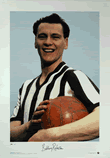 31 July: HFK salutes Sir Bobby Robson, who died peacefully at home this morning at the age of 76. Sir Bobby, who has been battling against cancer for the past 15 years, appeared at St James' Park on Sunday where 33,000 fans gathered to watch a re-run of the 1990 World Cup semi-final in aid of The Bobby Robson Foundation.
31 July: HFK salutes Sir Bobby Robson, who died peacefully at home this morning at the age of 76. Sir Bobby, who has been battling against cancer for the past 15 years, appeared at St James' Park on Sunday where 33,000 fans gathered to watch a re-run of the 1990 World Cup semi-final in aid of The Bobby Robson Foundation.
In an extraordinary turn of events, Livingston FC have been saved from liquidation. At a meeting held yesterday to which owner Angelo Massone was refused admission, the SFL relaxed its own rules and allowed a new company, Livingston 5 Ltd to take over the club. This company has been formed by former Dumbarton chairman Neil Rankine and ex-Cowdenbeath owner Gordon McDougall, who had previously made separate attempts to take over the club. If Massone continues to refuse to sell his shares in the club to the administrators, the SFL will allow the club to continue under their interim manager Donald McGruther of the administrators, Mazars, with funding from the new consortium. For the remarkable full story visit The Scotsman.
2009-10 additions: Nottingham Forest (H), Darlington (A), Manchester City (A), Fulham (A).
30 July 2009-10 additions: Dagenham & Redbridge (H), Lincoln City (A), Shrewsbury Town (H, A), Rotherham United (H), Port Vale (H), Cheltenham Town (H), Accrington Stanley (H, A), Rushden & Diamonds (H), Chelsea (3rd), Chester City (H).
29 July 2009-10 additions: Luton Town (H), Cambridge United (H updated), Peterborough United (3rd updated), Darlington (H).
Other updates: Luton Town (1899-1900),
28 July 2009-10 additions: Barnsley (A), Southend United (A), Wigan Athletic (A), Millwall (A), Forfar Athletic (H).
26 July 2009-10 additions: Aston Villa (H), Wycombe Wanderers (A), Brentford (A), Swindon Town (A), Portsmouth (A).
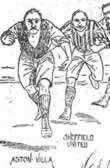 Kjell Hanssen recently sent us this sketch from The Liverpool Weekly Echo dated 16 December 1893. The drawing represents the state of the Football League tables at the time, with the First Division teams in a race for the title while the Second Division sides clamber up the promotion ladder (click the thumbnail to see to the full cartoon). I'm not sure we can set too much store on the accuracy of the shirts depicted but nevertheless, I really enjoyed this.
Kjell Hanssen recently sent us this sketch from The Liverpool Weekly Echo dated 16 December 1893. The drawing represents the state of the Football League tables at the time, with the First Division teams in a race for the title while the Second Division sides clamber up the promotion ladder (click the thumbnail to see to the full cartoon). I'm not sure we can set too much store on the accuracy of the shirts depicted but nevertheless, I really enjoyed this.
Frustration with Mike Ashley's regime at Newcastle United and the lack of progress over the sale of the club seems to have spilled over into a boycott of the brand new banana and custard away kit. According to BBC News just three fans queued to buy the much reviled shirt when it went on sale on July 23.
It looks as if Livingston's game in the Alba Cup on Saturday against Queen of the South will be their last. According to The Scotsman, the club's interim insolvency manager (Livi are now officially in administration) is likely to put the club directly into liquidation next week. If this occurs, the SFL will probably move one club up from each division and admit a new member into the Third Division for the second time in two seasons.
Other updates: West Ham United (1989-90 added): Hamilton Academical (1984-85, 1985-86 alt added; 1976-77, 1979-80, 2008-09 corrected): Sheffield Wednesday (1962-63): Wimbledon (1989-90, 1990-91 detailing added).
23 July 2009-10 additions: Leeds United (A), Cardiff City (H), Wolves (alternate H), Bolton Wanderers (A), Hereford United (A), Everton (A), Portsmouth (H), York City (H),
21 July 2009-10 additions: Berwick Rangers (updated), Stockport County (H, A), Macclesfield Town (H, A).
Contrary to earlier information on HFK, we now understand that Aston Villa will wear a new home kit in the coming season.
 20 July: The European arm of the New Zealand-based sportswear company, Canterbury, went into administration last week, blaming tough trading conditions, the falling pound and "an unsuccessful" move into other sports including football. Canterbury made their reputation by designing kits for the leading rugby clubs and national teams in the southern and later northern hemispheres. All contracts with UK football clubs have now been cancelled, throwing into doubt what Portsmouth (the biggest football club supplied by Canterbury in the UK), Preston and Motherwell will wear in the coming season. The administrators, KPMG, have stated that the company will continue to trade while a buyer is sought. The firm will continue to employ some staff in the meantime but 72 employees have been made redundant. HFK is informed by industry insiders that UK manufacturers of Canterbury's kits are facing six-figure losses, a hit that the shrinking UK manufacturing sector is ill-equiped to absorb. More information is on the BBC Online Website.
20 July: The European arm of the New Zealand-based sportswear company, Canterbury, went into administration last week, blaming tough trading conditions, the falling pound and "an unsuccessful" move into other sports including football. Canterbury made their reputation by designing kits for the leading rugby clubs and national teams in the southern and later northern hemispheres. All contracts with UK football clubs have now been cancelled, throwing into doubt what Portsmouth (the biggest football club supplied by Canterbury in the UK), Preston and Motherwell will wear in the coming season. The administrators, KPMG, have stated that the company will continue to trade while a buyer is sought. The firm will continue to employ some staff in the meantime but 72 employees have been made redundant. HFK is informed by industry insiders that UK manufacturers of Canterbury's kits are facing six-figure losses, a hit that the shrinking UK manufacturing sector is ill-equiped to absorb. More information is on the BBC Online Website.
2009-10 additions: Berwick Rangers (H, A), Brechin City (H, A), Dundee United (A), Hamilton Academical (H), Celtic (A), St Johnstone (H, A).
Other updates: Berwick Rangers (1984-85, 1985-86, 1987-88, 1989-90, 1990-91, 1992 added).
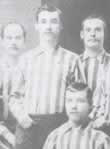 19 July: With help from HFK Research Associate, Geoff Bell, we have been doing some detective work on Wolverhampton Wanderers' early playing kits. Our main source is Percy Young's official history which states that the club adopted old gold and black in 1891 and adds, in a footnote, Previously jerseys with blue-and-white, then red-and-white vertical stripes had been worn. A reference on the Sports Prints website states The Club's first kit in the late 1870's was believed to have been blue and white striped shirts which then changed to faded red (sometimes described as pink) and white stripes due to West Bromwich Albion having adopted the same colours (my emphasis). This last statement is entirely credible because in 1889 the Football League required clubs to register their colours for the first time and insisted that no two teams could play in the same colours. West Brom had, in 1888, adopted scarlet and blue stripes but reverted to their older blue and white shirts after the press, with the casual attitude to racism typical of the Victorian period, described them as Nigger Minstrels.
19 July: With help from HFK Research Associate, Geoff Bell, we have been doing some detective work on Wolverhampton Wanderers' early playing kits. Our main source is Percy Young's official history which states that the club adopted old gold and black in 1891 and adds, in a footnote, Previously jerseys with blue-and-white, then red-and-white vertical stripes had been worn. A reference on the Sports Prints website states The Club's first kit in the late 1870's was believed to have been blue and white striped shirts which then changed to faded red (sometimes described as pink) and white stripes due to West Bromwich Albion having adopted the same colours (my emphasis). This last statement is entirely credible because in 1889 the Football League required clubs to register their colours for the first time and insisted that no two teams could play in the same colours. West Brom had, in 1888, adopted scarlet and blue stripes but reverted to their older blue and white shirts after the press, with the casual attitude to racism typical of the Victorian period, described them as Nigger Minstrels.
Geoff has provided two photographs, which I now believe show Wolves in their blue and white shirts. The first (above), taken in 1883-84 when the team won the Wrekin Cup, is possibly the first season that vertical stripes were worn (HFK believes earlier references to stripes were in fact descriptions of the horizontally striped jerseys that were commonplace before 1883). Note that several players have embellished their knickerbockers with extra 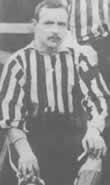 trim. The second picture, taken before Wolves' first game in the Football League against Aston Villa in 1888, (left) shows that these trimmings had become standard. Also note that H Fletcher (back row, left) has sewn the English FA crest on his club shirt, indicating that he had been capped for his country. Another intriguing detail is the dark patch sewn into the players' left sleeves: at first glance this looks like the armband worn as a mark of respect when someone involved with the club has died but in this instance, the patch is clearly attached to the shirt and does not pass all the way round the arm, which suggests it was part of the uniform.
trim. The second picture, taken before Wolves' first game in the Football League against Aston Villa in 1888, (left) shows that these trimmings had become standard. Also note that H Fletcher (back row, left) has sewn the English FA crest on his club shirt, indicating that he had been capped for his country. Another intriguing detail is the dark patch sewn into the players' left sleeves: at first glance this looks like the armband worn as a mark of respect when someone involved with the club has died but in this instance, the patch is clearly attached to the shirt and does not pass all the way round the arm, which suggests it was part of the uniform.
Click on the thumbnails to view the full picture.
In addition, Jonathon Russell has provided details of Wolves' 1910-11 kit and their 1908 FA Cup Final strip has been amended.
2009-2010 additions: AFC Bournemouth (H, A), Milton Keynes Dons (H, A).
Biffa has sent us a colour photograph of Newcastle United playing at Chelsea in 1979-80 which proves conclusively that Toon wore their pale yellow change shirts with their black home shorts in this game rather than white shirts as we had previously shown. Stoke City (1927-28 stockings now confirmed). Partick Thistle (1991-93 socks amended). Aberdeen (1963-64 corrected). Airdrieonians (1998-99 added).
17 July 2009-10 additions: Hereford United (H), Inverness Caledonian Thistle (H, A), Aldershot Town (H, A), Crewe Alexandra (H), Liverpool (third).
A complete set of shirts worn by the Doonhamers since 1970 has been posted on the Queen of the South official website, allowing us to amend some detailing to our Queen of the South section.
Tony Sealey has uncovered evidence that Tottenham Hotspur wore pale change shirts in the 1920s, almost certainly yellow. The decision taken in 1967 to adopt yellow in place of navy blue for Spurs' change colours may well have been inspired by this earlier, and until know, largely forgotten colour scheme.
15 July 2009-2010 additions: Chesterfield (H, A), Sheffield United (A), Birmingham City (H), Peterborough United (H, A & 3rd), Queen of the South (sponsorship added), Falkirk (H, A).
I have been following the crisis at Livingston FC, who are around £1.35m in debt and today faced a court hearing brought by their landlord, West Lothian Council, who are owed £300,000 in unpaid rent. A decision from the Court of Session is expected in the next few days and it is most likely that the club will be placed into administration and its affairs taken out of the hands of its controversial chairman, Angelo Massone, who is reported to have alienated creditors, supporters and officials. The club, whose only assets appear to be their players, could then be relegated to the Scottish Third Division under SFL rules, a decision that could cause havoc now that next season's fixtures have been set. For the full story visit the Scotsman Online.
14 July 2009-10 additions: Stoke City (H), Barnet (H, A), Raith Rovers (A).
12 July 2009-10 additions: Reading (A), Dumbarton (3rd), Exeter City (H), Southampton (H).
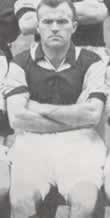 11 July 2009-10 additions: Raith Rovers (H), Aberdeen (3rd), Scunthorpe United (H, A), Colchester United (H), Charlton Athletic (H), Ross County (H, A), Bristol Rovers (H, A), Reading (H), West Ham United (H), Blackburn Rovers (H), Leicester City (A).
11 July 2009-10 additions: Raith Rovers (H), Aberdeen (3rd), Scunthorpe United (H, A), Colchester United (H), Charlton Athletic (H), Ross County (H, A), Bristol Rovers (H, A), Reading (H), West Ham United (H), Blackburn Rovers (H), Leicester City (A).
Our featured team photograph today is of Scunthorpe and Lindsey United (they dropped "and Lindsey" in 1958) taken before their debut match in Division Three (North) in 1950 and sent in by Richard Young. The claret and blue shirts feature a light blue yoke and an open collar in claret, a design that is, as far as I know, unique. More conventional collars were reinstated the following season.
8 July: The photograph showing Bob McGory leading out the Stoke City team in 1927-28 prompted HFK Research Associate Peter Wyatt to get in touch: This photo was not taken at the Victoria Ground as can be seen by the background. I don't know which ground it is (possibly Arsenal in the FA Cup quarter Final game) in March 1928 but the strip being worn is the change kit - blue and white stripes with navy blue knickers which was definitely worn in this game. 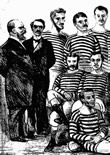 Red and white stripes with white knickers were worn throughout the 1927-32 season.
Red and white stripes with white knickers were worn throughout the 1927-32 season.
I am grateful to Lee Gauntlett from Birmingham University who sent us this charming print of the Aston Villa team from June 1882. The team are wearing navy and white hooped jerseys, a style very common around this time. The first record we have of Villa wearing this outfit comes from New Years' Day 1881, when I believe they changed from their previous claret tops for a challenge match against Hearts in Edinburgh. Lee has also submitted a rare programme from the Birmingham Challenge Cup final played in April 1883, which records Villa playing in the same colours. The inference is that the team played in these colours for at least two and half seasons rather than just in the Hearts match as we previously believed.
2009-10 additions: Heart of Midlothian (A), Wrexham (H), West Bromwich Albion (A), Oxford United (H), Blackpool (A), Burton Albion (H, A), Oldham Athletic (A).
There is a fascinating article about the "sportswear mafia" that dominates the UK sportswear retail market in The Guardian Online today.
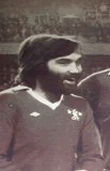 5 July 2009-10 additions: Rangers (H), Derby County (H), Tranmere Rovers (H, A), Manchester United (A). We are, as ever, grateful to everyone who alerts us to the new season's kits - there appears to be something of an unofficial competition going on to get a credit on the new season's galleries.
5 July 2009-10 additions: Rangers (H), Derby County (H), Tranmere Rovers (H, A), Manchester United (A). We are, as ever, grateful to everyone who alerts us to the new season's kits - there appears to be something of an unofficial competition going on to get a credit on the new season's galleries.
We're always pleased to hear from collectors of football shirts and proud that HFK is regarded within the collecting fraternity as a valuable resource. Some time ago Richard (no surname supplied) sent us some pictures from his collection of over 100 Chelsea shirts that has helped us add some missing detailing and several rare away kits to our records. Pride of place in Richard's collection goes to the shirt worn by George Best when he appeared for the club in 1974-75. (Click on the image to see the very shirt the great man wore.)
The stockings worn by England in their game against Wales on 23 November 1960 are now correct.
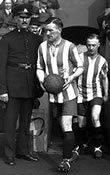 Other updates: Crystal Palace (1959-61 added): Hereford United (1947-48, circa 1949 added): Manchester United (1937-38 added): Stoke City (1927-28, 1947-48 added): the kit worn by Arsenal against Barnsley in the FA Cup in 1936 has been corrected: Mansfield Town (1926-31 shirt corrected).
Other updates: Crystal Palace (1959-61 added): Hereford United (1947-48, circa 1949 added): Manchester United (1937-38 added): Stoke City (1927-28, 1947-48 added): the kit worn by Arsenal against Barnsley in the FA Cup in 1936 has been corrected: Mansfield Town (1926-31 shirt corrected).
The photograph on the left, sent to us by the indefatigable Simon Monks from his extensive collection, is of particular interest. It shows the Stoke City captain leading the team out in March 1928 and helps fill in a seven-year gap in our records. The players are wearing black knickers, an unusual departure for the club who normally wore white knickers with their famous red and white striped tops. We would very much like to receive more information about the club's kits between 1925 and 1932.
A question that you may be asking is why do so many corrections appear on HFK? Is it because we're too lazy to check everything? The answer is that more often than not we are working from written references that are unhelpfully vague and frequently have to make assumptions about some details. As the number of regular contributors to HFK grows, we are in the privileged position of having access to a growing number of collections of old photographs, which we use to add missing details.
3 July 2009-10 additions: Greenock Morton (H, A & 3rd), Swindon Town (H), Bradford City (H, A), Hull City (H, A), Arsenal (3rd), Bury (H, A), Yeovil Town (H), Gillingham (H, A), Brighton (H, A & 3rd), Manchester City (H), Sheffield United (H).
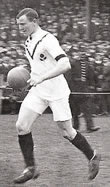 Earlier this week I wrote to Manchester United to ask for clarification of the text on their website that suggested the new United shirt is based on a design worn in 1910-11 (see 26 June item). Although I have not had an official response, I did note that the morning after I sent my e-mail, the wording on the United site had been changed and now reads reflecting the design of the shirts worn by United when the team won its first FA Cup in 1909 wearing white shirts with a red chevron. A spokesperson from Nike also confirmed that the design took inspiration (my emphasis) from several elements of the club's history and the 1909 Cup Final kit ... is one that was referenced in the process. Today's photograph, which comes from United Kits Through the Ages shows the FA Cup Final strip in question. Does this justify United/Nike's claims? We'll let you decide. In the meantime our Research Associate, Paul Nagel, urgently needs a photograph of the United team of 1909-10: if you can help, please contact me.
Earlier this week I wrote to Manchester United to ask for clarification of the text on their website that suggested the new United shirt is based on a design worn in 1910-11 (see 26 June item). Although I have not had an official response, I did note that the morning after I sent my e-mail, the wording on the United site had been changed and now reads reflecting the design of the shirts worn by United when the team won its first FA Cup in 1909 wearing white shirts with a red chevron. A spokesperson from Nike also confirmed that the design took inspiration (my emphasis) from several elements of the club's history and the 1909 Cup Final kit ... is one that was referenced in the process. Today's photograph, which comes from United Kits Through the Ages shows the FA Cup Final strip in question. Does this justify United/Nike's claims? We'll let you decide. In the meantime our Research Associate, Paul Nagel, urgently needs a photograph of the United team of 1909-10: if you can help, please contact me.
26 June 2009-10 additions: The eagerly awaited new Manchester United kit has been officially revealed and added to the new season galleries. The shirt is marketed as being based on a design worn in 1910-11: HFK is not so sure and would like to get hold of some team photographs from that season to see if this claim can be verified. Alloa Athletic (A), Swansea City (H, A), Port Vale (A, 3rd) added.
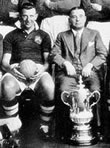 We have not had a photograph for a few days so here's one from Alex Howells of the 1934 Manchester City FA Cup winning team to enjoy. (As usual, click on the thumbnail image to view the entire image). City are wearing the same shirts that they wore in the previous season's final, when City and Everton flipped a coin for the choice of maroon or white tops. A clash of colours between City and Portsmouth in the 1934 final resulted in another change of shirt for both teams but we don't know if this was also decided by lot. In the event City wore maroon again, won the cup and adopted this colour as their favoured change kit for the next 40 years.
We have not had a photograph for a few days so here's one from Alex Howells of the 1934 Manchester City FA Cup winning team to enjoy. (As usual, click on the thumbnail image to view the entire image). City are wearing the same shirts that they wore in the previous season's final, when City and Everton flipped a coin for the choice of maroon or white tops. A clash of colours between City and Portsmouth in the 1934 final resulted in another change of shirt for both teams but we don't know if this was also decided by lot. In the event City wore maroon again, won the cup and adopted this colour as their favoured change kit for the next 40 years.
FC Toronto recently played New York Red Bulls wearing a special pink strip in aid of breast cancer research. HFK has contacted the club to find out how supporters can buy these special shirts and will post the results as soon as we have a reply.
Berwick Rangers (1998-99 kit manufacturer details added): Bristol City (2000-01 shorts corrected, 1992-94 manufacturer corrected):
25 June 2009-10 additions: Brentford (H), Chelsea (A).
Christopher Worrall and Doug Shulman have been busy burrowing through the records of Cambridge United and have added eight previously unrecorded kits to our records (1948-49, 1949-50, 1950-51, 1963-64, 1968-69, 1971-72, 1978-79, 1987-88) and corrected several more.
23 June 2009-10 additions: The new Newcastle away kit has been posted in the 2009-10 Championship gallery (HFK received dozens of e-mails from astonished visitors about this kit), Bristol City (A).
Doncaster Rovers (May-Sept 1997 alternate): Wolverhampton Wanderers (1870s kit modified, 1891-92 dates amended).
20 June 2009-10 additions: West Bromwich Albion (H), Watford (A + sponsorship added).
 The champions of the Coca Cola Football Leagues One and Two will wear these special gold sleeve patches next season. If we're going to have sleeve patches (and it appears that we will my dears), wouldn't it be nice for clubs that move up to the Premier League from the Championship to wear a Championship Winners patch and for the Conference winners to wear a Conference Champions patch in their first seasons at the higher level. Alas, marketing and copyright issues make this unlikely to ever happen.
The champions of the Coca Cola Football Leagues One and Two will wear these special gold sleeve patches next season. If we're going to have sleeve patches (and it appears that we will my dears), wouldn't it be nice for clubs that move up to the Premier League from the Championship to wear a Championship Winners patch and for the Conference winners to wear a Conference Champions patch in their first seasons at the higher level. Alas, marketing and copyright issues make this unlikely to ever happen.
In 1998 Doncaster Rovers crashed out of the Football League for the third time with just eight points. By special request from our reasearch associate, Christopher Worrall, their change kit for that dreadful season is now in Room 101.
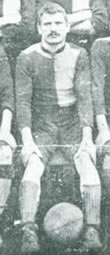 18 June: Further to yesterday's feature on Newton Heath, here is a photograph of the team that played in the Football League for the first time in 1892-93 and registered as "red and white quarters." The body panels are reversed on the back, the sleeves are solid red while a laced crew neck replaces the collars on the earlier shirts.
18 June: Further to yesterday's feature on Newton Heath, here is a photograph of the team that played in the Football League for the first time in 1892-93 and registered as "red and white quarters." The body panels are reversed on the back, the sleeves are solid red while a laced crew neck replaces the collars on the earlier shirts.
2009-10 additions: Middlesbrough (H), Wycombe Wanderers (H), Rochdale (H, A), Yeovil Town (A), Leyton Orient (H, A).
To date HFK has, with help from our regular visitors, slightly more than a third of next season's English and Scottish kits. Some trends are emerging so it is time for a little rant. The big global players (Nike/Umbro, Puma and Adidas) will produce a bespoke kit for the major clubs where huge replica sales can be expected but for the rest, choice is limited to standard templates perhaps with slightly different detailing. The small players with a reputation for innovation are being squeezed. Middlesbrough and Crystal Palace, for example have switched from the Italian company Errea to Adidas and Nike respectively and will turn out in very ordinary looking strips this August. Now I am quite a fan of Nike's minimalist design approach but it does mean clubs have little influence on the final design, which is why Rochdale have switched to Carbrini.
The smaller companies (Errea, Mitre, Joma, Le Coq Sportif, Canterbury. Macron, Bukta, Xara) are where we find interesting, innovative and even elegant designs alongside a commitment to involve clubs in the design process. The more forward looking clubs now actively involve supporters by offering a vote between several options. Sheffield United went one step further last season with a kit designed by a season ticket holder while Cambridge United's excellent new outfit was designed by a supporter. HFK would like to see more of this at all levels.
I quite like the new Lotto and Carbrini designs but they are disfigured by excessive placement of the makers' logos. When you put this together with secondary sponsorship, competition patches, the main shirt sponsor and all the other clutter that goes onto modern shirts the overall effect diminishes the team's identity.
Finally, I was distressed to read some very negative comments on one of Wigan Athletic's discussion boards over the decision to switch to Vandanel. This French company have produced consistently good designs for many seasons and to criticise the decision because they have previously been associated with teams in the lower leagues smacks of brand snobbery.
17 June: We have quite a lot of Manchester United material to work through today. First of all, Paul Nagel has uncovered evidence that Newton Heath adopted red and white shirts in 1888 rather than 1892 as we had previously thought with this reference from The Definitive Newton Heath FC (Shury & Landamore):
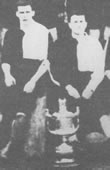 In friendly matches with Football League clubs at the start of the season, Newton Heath lost to Stoke and drew with Bolton Wanderers. The report of the latter game mentions 'Powell and his men in their familiar red and white costumes'. Though Newton Heath are generally known for playing in green and gold shirts, the colours registered with the Football League in 1892 were 'red and white quartered shirts, blue shorts'. By
In friendly matches with Football League clubs at the start of the season, Newton Heath lost to Stoke and drew with Bolton Wanderers. The report of the latter game mentions 'Powell and his men in their familiar red and white costumes'. Though Newton Heath are generally known for playing in green and gold shirts, the colours registered with the Football League in 1892 were 'red and white quartered shirts, blue shorts'. By 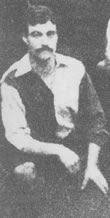 'quarters' it was meant that the shirts were 'halved' on the front and the back, as can be seen from the group photographs. For further details on this story visitTim Ashmore's United Kits Blog where this evidence was first published.
'quarters' it was meant that the shirts were 'halved' on the front and the back, as can be seen from the group photographs. For further details on this story visitTim Ashmore's United Kits Blog where this evidence was first published.
The reference to "quarters" confirms my own research, which indicates that in Victorian times this term was applied to shirts we would describe as "halved" possibly because the body of the shirt was made up of four panels stitched together. Quartered shirts in the modern sense were called "harlequin."
The first image (above left) shows the team from 1889 mentioned above whereas that on the right dates from the 1891-92 season. The 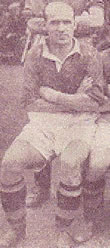 sleeves are now reversed front and back but, intriguingly, the rear panel on the players' left appears to be white and not reversed. Clearly it is impossible to tell from these what colours the shirts were so Paul's findings are of considerable significance.
sleeves are now reversed front and back but, intriguingly, the rear panel on the players' left appears to be white and not reversed. Clearly it is impossible to tell from these what colours the shirts were so Paul's findings are of considerable significance.
Our next item come from Alex Howells and shows the team in April 1948 wearing unusual (for United) hooped stockings. We've already had evidence from Alex that the team wore black socks with a red/blackturnover between 1946 and 1949 and must assume this was a variant used towards the end of the 1947-48 season. We've already noted that clothing shortages after the war led to all sorts of oddities and this may be another example.
The final photograph (right), also provided by Alex Howells shows the United team lining up before their European Cup match in Belgrade on 5 February, 1958. This famous image has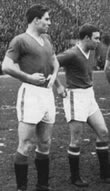 somehow escaped HFK's attention but it raises a number of interesting questions. First of all a stripe appears on the shorts: this was also worn in the previous round against Dukla Prague. As we have already established (see entry for 14 June), this feature was part of United's new white change kit adopted the previous season but I have no evidence that it was worn in domestic games, giving rise to the suggestion that this was an early "European kit."
somehow escaped HFK's attention but it raises a number of interesting questions. First of all a stripe appears on the shorts: this was also worn in the previous round against Dukla Prague. As we have already established (see entry for 14 June), this feature was part of United's new white change kit adopted the previous season but I have no evidence that it was worn in domestic games, giving rise to the suggestion that this was an early "European kit."
There is something of a puzzle over what the two clubs wore in this tie - Red Star's colours were also red and white. The teams wore the same kits in both legs of the tie, Red Star playing in dark shirts and (probably) dark blue shorts, which leads me to believe that they changed in both games and United wore their usual red and white but I have not been able to confirm this.
It was on the return flight from Belgrade that United's chartered aircraft crashed at Munich airport, killing 23 of the 44 passengers, including eight members of the first team.
16 June 2009-10 additions: Dundee United (H).
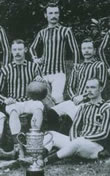 Thanks to David Heaton, a number of missing change kits have been added to the Aston Villa section (1962-63, 1963-64, 1964-65, 1973-74, 1975-76). I've also uncovered evidence that during the late 1870s, Villa wore white shirts and green ones at some stage but details remain sketchy I now believe the club first wore claret or maroon jerseys for the first time in 1881. The team borrowed a set of navy and white hooped jerseys when they played Heart of Midlothian on New Year's Day, 1881, which suggests that they had adopted similar colours by that time. The earliest photograph I have found of Villa to date is this famous one, courtesy of the informative Spartacus Educational site, with the FA Cup. At the time the dark stripes were sometimes described as chocolate but I believe this was a term used by press correspondents to describe the dark red that would later become universally known in England as "claret."
Thanks to David Heaton, a number of missing change kits have been added to the Aston Villa section (1962-63, 1963-64, 1964-65, 1973-74, 1975-76). I've also uncovered evidence that during the late 1870s, Villa wore white shirts and green ones at some stage but details remain sketchy I now believe the club first wore claret or maroon jerseys for the first time in 1881. The team borrowed a set of navy and white hooped jerseys when they played Heart of Midlothian on New Year's Day, 1881, which suggests that they had adopted similar colours by that time. The earliest photograph I have found of Villa to date is this famous one, courtesy of the informative Spartacus Educational site, with the FA Cup. At the time the dark stripes were sometimes described as chocolate but I believe this was a term used by press correspondents to describe the dark red that would later become universally known in England as "claret."
Missing detailing has been added to some Brighton kits (1985-86, 1986-87, 1994-97) and to those of Notts County (1986-87, 1987-88).
15 June: A graphic of Broadfield FC's 1880 kit has been added; this club became Port Glasgow Athletic in 1881 and spent 18 years in Scottish Division Two before resigning in 1911. The Eminent Victorians gallery has been considerably extended with the addition of interesting early Scottish kits worn by clubs that did not appear in the Scottish Football League. My source for this material is Brian McColl's outstanding Scottish Football Club Directory, itself an extraordinary achievement and just a small part of Brian's definitive statistical History of Scottish Football. If you have even a passing interest I urge you to explore this site.
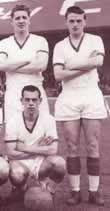 14 June 2009-10 additions: Tottenham Hotspur (H, A & 3rd).
14 June 2009-10 additions: Tottenham Hotspur (H, A & 3rd).
Today's photograph appears courtesy of Alex Howells and shows Manchester United wearing their brand new all-white kit on 27 April 1957 before the game with Cardiff City. There was no reason for the team to change for this match and Alex speculates that this was a try-out prior to the FA Cup final against Aston Villa due to take place five days later (when both teams wore change kits). It is, therefore, the first occasion that United wore white instead of their traditional blue and white change strip and was almost certainly inspired by United's encounters with Real Madrid earlier in the season. The centenary version of United's 1978-79 change kit has been added to the Manchester United Away Kits section as has the strip worn in the Champions League final last month.
12 June 2009-10 additions: Clyde (H, A), Cambridge United (H), Grimsby Town (H, A), Ipswich Town (H), Fulham (H).
.jpg) 10 June: Today's featured team is Liverpool from 1946-47. The surprisingly modern looking shirts were first worn in the early Thirties and it is possible that an old set was used immediately after the war. Although professional football had been reinstated, clothing was still rationed and clubs could only replace their worn out strips by collecting unwanted coupons from their supporters. Even then, shortages meant that some traditional patterns were unobtainable. Many teams pressed old pre-war strips into service as a stop gap measure.
10 June: Today's featured team is Liverpool from 1946-47. The surprisingly modern looking shirts were first worn in the early Thirties and it is possible that an old set was used immediately after the war. Although professional football had been reinstated, clothing was still rationed and clubs could only replace their worn out strips by collecting unwanted coupons from their supporters. Even then, shortages meant that some traditional patterns were unobtainable. Many teams pressed old pre-war strips into service as a stop gap measure.
2008-09 additions: East Fife (H, A, 3rd).
Our latest Research Associate is Craig Edmondson who has provided details of all the missing Aldershot Town kits and corrected several innacurate entries (1995-97, 1997-98, 2000-02 added).
7 June 2009-2010 additions: Everton (H), Sunderland (A). While compiling the new season's kits I particularly enjoy reading the fatuous blurb written by manufacturers' PR departments, which at its best combines desperate hyperbole with a complete disregard for the English language. Thus, Morecambe's new away kit has curved side panels for "added dynamicity," Sunderland's has "impactful carbon sleeves" and Hibs now have an 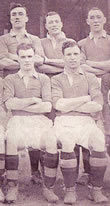 "interchangeable kit system." Do let me know if you come across similar nonsense and we will publish the results here.
"interchangeable kit system." Do let me know if you come across similar nonsense and we will publish the results here.
Our featured team today is Manchester United from 1946-47. Thanks to Alex Howells, we have established that United wore black stockings with a black and red turnover just after the war, possibly because clothing shortages meant they could not get hold of their usual socks. The white band on the turnover was reinstated in 1949-50. You may also be interested in Tim Ashmore's splendid new blog that looks in detail at the history of United's kits and features what is believed to be the first film footage of United in action.
East Fife (1997-98, 2002-03 corrected); Hull City (1988-89, 1989-90, 1998-99 now have the correct manufacturers).
4 June 2009-2010 additions:Queen of the South (H&A), Morecambe (H&A), West Ham United (A), Watford (H).
Several additions have been made to the Peterborough United section and most of the gaps filled in thanks to Nick Warrick. Nick has a fine collection of Posh shirts available at the Warrick Collection.
1 June: Details of Saturday's match are now in our FA Cup Finals section. I was interested to note that Chelsea opted to wear their yellow third kit rather than their black change outfit, an excellent choice for a beautiful, sunny day. Swindon Town (2008-09 third kit added).
2009-2010 additions: Stenhousemuir (H), St Mirren (H), Motherwell (H), Barnsley (H).
Iconic Away Kits new arrivals: West Ham United 1980, Reading 1991 & 1993, Sheffield Wednesday 1986 & 1995, Swindon Town 1992.
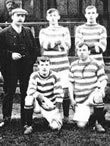 28 May: Pictured today is the East Fife team from around 1907-08 in their original green and white hoops. The picture is from the excellent collection to be found on the Away From the Numbers site, found by Christian Larsen. Several missing kits have been added to the Fifers' section (circa1907-08, 1954-55, 1957-59, 1963-64). I'm also grateful to Reg James who has corroborated the two undated Rangers change kits to 1959-60. It's alway satisfying to have these little anomolies cleared up.
28 May: Pictured today is the East Fife team from around 1907-08 in their original green and white hoops. The picture is from the excellent collection to be found on the Away From the Numbers site, found by Christian Larsen. Several missing kits have been added to the Fifers' section (circa1907-08, 1954-55, 1957-59, 1963-64). I'm also grateful to Reg James who has corroborated the two undated Rangers change kits to 1959-60. It's alway satisfying to have these little anomolies cleared up.
Doncaster Rovers (1944-47, 1951-52 added): Southend United (1991-92 added): Peterborough United (1970-71 added): Blackpool (1908-09, 1925-36, 1931-32, 1932-33, 1978-79 added).
2009-10 additions: Blackburn Rovers (A), Birmingham City (A), Aberdeen (H), Hearts (H), Hibernian (H), Plymouth Argyle (H), Millwall (H), Stoke City (A).
27 May: We are pleased to announce that the new season galleries for 2009-10 are now open. Over the summer and with your help, we will be posting the new kits as they are released.
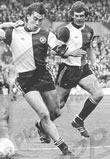 23 May: I've had many enquiries about the Queens Park Rangers change kit that appears in the Iconic Away Kits section that features an Umbro-made shirt with Adidas shorts and stockings, so here is the evidence, courtesy of Pete's Picture Palace.
23 May: I've had many enquiries about the Queens Park Rangers change kit that appears in the Iconic Away Kits section that features an Umbro-made shirt with Adidas shorts and stockings, so here is the evidence, courtesy of Pete's Picture Palace.
Arsenal 2009-10 away kit added. Aston Villa (1905, 1930-31, 1945 change kits added; 2001-02 home stockings corrected). Thanks to Peter Ferrette, we have learned that there were two Forest (or Forrest) football clubs in Victorian times: the first changed their name to Wanderers in 1864 (going on to win five FA Cups) while the second was formed in 1869, going out of business just three years later.
Thanks once again to Christopher Worrall, we have been able to add several early kits to the Doncaster Rovers section (1890-91, 1901-02, 1902-13, 1904-05) and added Donny's chocolate and mustard 1975-78 kit to the Iconic Away Kits section.
I have uncovered evidence (The Knowledge: Guardian Books 2008) that the first senior team in the UK to wear sponsored shirts was in fact Kettering Town, who, on January 24 1976, wore shirts with "Kettering Tyres" emblazoned across the chest. Four days later they were ordered by the FA to remove the offending logo (although, as the club protested at the time, the ban on advertising was not actually written into the FA rules at the time). The full story is in our A Brief History of Football Kits section.
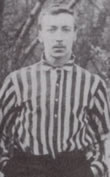 21 May: Thanks to Peter Gillatt we have been able to add several kits to the Blackpool section. (1904-05, 1928-29, 1975-76 alternate, 1995-96 added.) The photograph today is of the 1890 team, who were known as "The Merry Stripes" because of their blue and white shirts. Note how fine the stripes are - a typical pattern from this period. From a distance, however, the stripes would tend to blend into each other, which may explain why broader 2-inch stripes were coming into fashion at around this time. By the turn of the century these 1-inch stripes had virtually disappeared in favour of 2- and 3-inch versions, which stood out more clearly at a distance on dim winter afternoons.
21 May: Thanks to Peter Gillatt we have been able to add several kits to the Blackpool section. (1904-05, 1928-29, 1975-76 alternate, 1995-96 added.) The photograph today is of the 1890 team, who were known as "The Merry Stripes" because of their blue and white shirts. Note how fine the stripes are - a typical pattern from this period. From a distance, however, the stripes would tend to blend into each other, which may explain why broader 2-inch stripes were coming into fashion at around this time. By the turn of the century these 1-inch stripes had virtually disappeared in favour of 2- and 3-inch versions, which stood out more clearly at a distance on dim winter afternoons.
Luton Town's 1991 change kit is now in the Iconic Away Kits section.
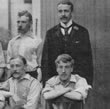 19 May: Let's stay with yesterday's Victorian theme with this interesting photograph of the 1894 Marlow team, sent to HFK by our Victorian Research Associate, Peter Ferrette. The shirts were described as "quartered" just as those of Blackburn Rovers were. We can conclude that this term referred to shirts that were made up of four, contrasting body panels with the colours reversed on the back, a pattern that we would call "halved." I have also come across references to teams wearing "harlequin" shirts and we now have evidence that this referred to shirts made from eight panels, or "quartered" as we would now call them.
19 May: Let's stay with yesterday's Victorian theme with this interesting photograph of the 1894 Marlow team, sent to HFK by our Victorian Research Associate, Peter Ferrette. The shirts were described as "quartered" just as those of Blackburn Rovers were. We can conclude that this term referred to shirts that were made up of four, contrasting body panels with the colours reversed on the back, a pattern that we would call "halved." I have also come across references to teams wearing "harlequin" shirts and we now have evidence that this referred to shirts made from eight panels, or "quartered" as we would now call them.
David Rice has been researching the photograph we published on 29 March, courtesy of Peter Ferrette, and attributed to the Old Carthusians 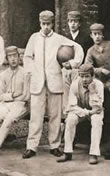 club. David has established that it is in fact a photograph of the Charterhouse School team and includes the sons of one baronet, one marquess and a viscount. David believes it was taken when Charterhouse played Westminster in the first ever inter-school football match. At the time the public schools each played under their own rules but the young man holding the ball, Charterhouse's captain BF Hartshorne, took part in the meeting at the Freemason's Tavern on 26 October 1863 that led to the formation of the Football Association and the drawing up of a uniform set of rules. Hartshorne was the only representative from a public school, some of whom still play under their original rules to this day.
club. David has established that it is in fact a photograph of the Charterhouse School team and includes the sons of one baronet, one marquess and a viscount. David believes it was taken when Charterhouse played Westminster in the first ever inter-school football match. At the time the public schools each played under their own rules but the young man holding the ball, Charterhouse's captain BF Hartshorne, took part in the meeting at the Freemason's Tavern on 26 October 1863 that led to the formation of the Football Association and the drawing up of a uniform set of rules. Hartshorne was the only representative from a public school, some of whom still play under their original rules to this day.
Blackpool (sponsor's logo amended 1988-89, 1989-90): Liverpool (2009-10 away kit added). For his outstanding research into Wycombe Wanderers, Dave Peatey is inducted as an HFK Research Associate. Dave's latest contributions include confirmation that the Chairboys wore striped shirts in the first quarter of the twentieth century. (1906-17, 1908-19, 1909-10, 1924-25, 1973-74, 1975-76 added.)
 18 May: Yesterday, Sunday 17 May, was designated National Famine Memorial Day by the Irish government to commemorate the Great Famine of 1845-52 in which up to a quarter of the Irish population perished or were forced to emigrate. To mark the occasion, Celtic wore the Celtic Cross, the symbol of the club's charitable arm, on their shirts yesterday. Celtic have strong links with Ireland and were set up by Brother Walfrid, a member of the Irish Marist Order in 1888. It is particularly fitting that their opponents yesterday were Hibernian, the first of many Scottish clubs set up as charitable institutions by the Catholic clergy to relieve poverty among the large Irish community that had settled in Scotland to escape the famine and who lived in abject poverty.
18 May: Yesterday, Sunday 17 May, was designated National Famine Memorial Day by the Irish government to commemorate the Great Famine of 1845-52 in which up to a quarter of the Irish population perished or were forced to emigrate. To mark the occasion, Celtic wore the Celtic Cross, the symbol of the club's charitable arm, on their shirts yesterday. Celtic have strong links with Ireland and were set up by Brother Walfrid, a member of the Irish Marist Order in 1888. It is particularly fitting that their opponents yesterday were Hibernian, the first of many Scottish clubs set up as charitable institutions by the Catholic clergy to relieve poverty among the large Irish community that had settled in Scotland to escape the famine and who lived in abject poverty.
 Team photographs from the Victorian period have a particular charm and we are always pleased to receive and share them. This is from David Rice's collection and is an original print of The Wednesday from 1875, which makes it the oldest photograph of the team that I have come across. These previously unrecorded plain blue shirts have been added along with a kit from 1962-63 to the Sheffield Wednesday section.
Team photographs from the Victorian period have a particular charm and we are always pleased to receive and share them. This is from David Rice's collection and is an original print of The Wednesday from 1875, which makes it the oldest photograph of the team that I have come across. These previously unrecorded plain blue shirts have been added along with a kit from 1962-63 to the Sheffield Wednesday section.
2009-10 additions: Wigan Athletic, Bolton Wanderers, Kilmarnock, Crystal Palace.
Iconic Away Kits added: Brighton 1991, Liverpool 1996, Peterborough United 1993. Brighton's 1991-93 home kit has been tweaked with missing pinstripes.
13 May: More from Chris Worrall today: Doncaster Rovers (1910-11, 1920-21, 1931-32, 1966-67 added: badges amended 1975-1978 and various tweaks made to later kits). Added to the Iconic Away Kits gallery: Leeds United (1999-2000), Southampton (1984 third kit), Doncaster Rovers (1973-74).
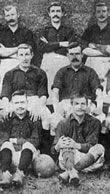 11 May: Please give a warm round of applause to Chris Worrall, who has been labouring away for the last five months on research for HFK. Today we present the first fruits of his labours in the shape of a significant revision of the Brighton & Hove Albion gallery, which now includes details for Albion's predecessors. Brighton United (pictured on the left in their green tops) were Brighton's first professional team but folded after only two seasons. Former members then formed a new side which merged with North End Rangers and played for one season as Brighton & Hove Rangers before they changed the name to Albion in 1901. Incidentally, you may notice that the red, white and blue kit from 1934 has been removed. We are currently trying to corroborate when, or even if these shirts were worn.
11 May: Please give a warm round of applause to Chris Worrall, who has been labouring away for the last five months on research for HFK. Today we present the first fruits of his labours in the shape of a significant revision of the Brighton & Hove Albion gallery, which now includes details for Albion's predecessors. Brighton United (pictured on the left in their green tops) were Brighton's first professional team but folded after only two seasons. Former members then formed a new side which merged with North End Rangers and played for one season as Brighton & Hove Rangers before they changed the name to Albion in 1901. Incidentally, you may notice that the red, white and blue kit from 1934 has been removed. We are currently trying to corroborate when, or even if these shirts were worn.
10 May: Aston Villa (1966-67 change and 1982 European Cup final kits added). Carlisle United (1998 away) added to the Iconic Away Kits section. Burnley (2009-10 added).
8 May: The History of Football Kits article has been substantially revised and expanded with additional photographs from HFK's growing archive.
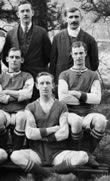 Macclesfield Town (2008-09 third kit added): Rotherham United (March 1968, 1973-74 added; kits between 1975 and 1980 now have the correct white cuffs). Wycombe Wanderers (1949-50, 1955-56, 1959-63, 1963-64, 1979-80 added; collar detailing corrected on 1946-48 and 1956-59 kits). The photograph is of Wycombe in 1919-20 when they played in the Spartan League.
Macclesfield Town (2008-09 third kit added): Rotherham United (March 1968, 1973-74 added; kits between 1975 and 1980 now have the correct white cuffs). Wycombe Wanderers (1949-50, 1955-56, 1959-63, 1963-64, 1979-80 added; collar detailing corrected on 1946-48 and 1956-59 kits). The photograph is of Wycombe in 1919-20 when they played in the Spartan League.
Luke Conboy tells us that Brighton will drop their light blue third kit next season. Given the increasing tendency of match officials to interfere in team's choice of kit, having blue on all three sets was probably not a good idea and an additional set of white kits had to ordered part way through this season. It's a shame, however, that the board of the team representing the capital of England's gay community seem to have rejected calls for the new kit to be pink.
The Liverpool (1988) and Celtic (1997) kits have been added to the Iconic Away Kits section.
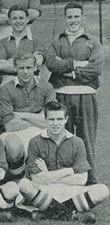 6 May: Geoff Allen has provided some more material concerning the elusive turqouise shirts worn by Watford. I first came across a reference to the turquoise kit in Bob Bickerton's book 'Club Colours' which claims it was worn from 1946-1959 so I wrote to Oliver Phillips (writer of the Centenary book) a few years ago and his reply was ".. we used to watch Watford play in plain blue. Some magazines described it as turquoise, others as royal blue. No one I knew ever talked about a change of shade, only that the blue became more faded with the soaping and the washing of the shirts and beating them on the stones in the (River) Colne during the season.". Well I have odd programmes starting from the 1947-48 season and they all refer to royal blue shirts on the team line up page although a black & white team line up photo of the 1949-50 season does look lighter then later photos. Maybe they did wash them too much! Our photograph today is of the Watford team from 1953-54.
6 May: Geoff Allen has provided some more material concerning the elusive turqouise shirts worn by Watford. I first came across a reference to the turquoise kit in Bob Bickerton's book 'Club Colours' which claims it was worn from 1946-1959 so I wrote to Oliver Phillips (writer of the Centenary book) a few years ago and his reply was ".. we used to watch Watford play in plain blue. Some magazines described it as turquoise, others as royal blue. No one I knew ever talked about a change of shade, only that the blue became more faded with the soaping and the washing of the shirts and beating them on the stones in the (River) Colne during the season.". Well I have odd programmes starting from the 1947-48 season and they all refer to royal blue shirts on the team line up page although a black & white team line up photo of the 1949-50 season does look lighter then later photos. Maybe they did wash them too much! Our photograph today is of the Watford team from 1953-54.
My thanks to Donald Gellatly who has provided details of the missing manufacturers for the Dundee gallery. Ross County (2006-07 sponsors details corrected).
Today we have more additions to the Iconic Away Kits section: Bristol City (1992-93), Aberdeen (1995), Carlisle United (2007 third), Tottenham Hotspur (1991), Brighton (1985), Burnley (1969), Manchester City (1969), Liverpool (1978). Preston North End's 2006-07 kit has been consigned to Room 101.
I'd like to draw your attention to the excellent Playing for the Shirt website, a thoroughly researched and well designed history of the shirts worn by Glentoran FC from 1882 to the present.
Further to yesterday's item, Ralph Pomeroy has pointed out he has over 116 sets of Subbuteo figures, all hand painted on celluloid (not cardstock) just like the original commercially produced figures.
 4 May: HFK is often used by collecters to verify and date shirts but some more esoteric hobbies are pursued by our regular visitors. Among these are those who collect and paint Subbuteo figures, which include long-time HFK contributer, Ralph Pomeroy, who sent in this nice picture from his collection. Ralph has made these in the original cardstock format used between 1947 and 1961, before the modern plastic figures were introduced.
4 May: HFK is often used by collecters to verify and date shirts but some more esoteric hobbies are pursued by our regular visitors. Among these are those who collect and paint Subbuteo figures, which include long-time HFK contributer, Ralph Pomeroy, who sent in this nice picture from his collection. Ralph has made these in the original cardstock format used between 1947 and 1961, before the modern plastic figures were introduced.
Southend United (2009-10 added). Rotherham United (2008-09 third kit added). Added to the Iconic Away Kits gallery: Wigan Athletic (1993), Leeds United (1994), Stockport County (1968), Southampton (1976, 1981).
2 May: Arsenal (2008-09 alternate added, 2007-08 3rd kit stockings corrected), Southampton (2008-09 variant of home kit added). Queens Park Rangers (1976), Manchester United (1993), Preston NE (2004), Motherwell (1976) added to our new Iconic Away Kits section. Plymouth Argyle (2009-10 added).
1 May: The nominations for our new Iconic Away Kits section have started coming in: Stoke City (1976), Walsall (1996-97) added. New kits for 2009-10 added today: Chelsea, Leeds United, Wolves.
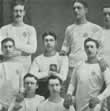 29 April: New Feature! We have no plans, as regular visitors know, to add "away" kits to HFK - to research and record these for every club on the site would be an impossible task. We are, however, grateful to Neil Rawlings who came up with the suggestion that we add a section to illustrate some of the best, worst and just plain daft change/away kits. You are welcome to visit our new Iconic Away Kits gallery and to nominate your own favourites. (Pictured on the left is the Rangers team from 1877 wearing the earliest example of a change kit I have yet come across: the white shirts were those of a rowing club that several players belonged to).
29 April: New Feature! We have no plans, as regular visitors know, to add "away" kits to HFK - to research and record these for every club on the site would be an impossible task. We are, however, grateful to Neil Rawlings who came up with the suggestion that we add a section to illustrate some of the best, worst and just plain daft change/away kits. You are welcome to visit our new Iconic Away Kits gallery and to nominate your own favourites. (Pictured on the left is the Rangers team from 1877 wearing the earliest example of a change kit I have yet come across: the white shirts were those of a rowing club that several players belonged to).
Whether to render our graphics with short or long sleeves has become a rather vexed question of late, prompting more than a few questions in HFK's inbox. It used to be straightforward: sleeves were long and worn rolled up to the elbow until 1955 when the first "continental style" kits appeared. (A few elbow-length sleeved shirts had actually appeared before the Second World War.) Long sleeves returned in the 1960s but from around 1970 teams often wore short sleeved shirts during the warmer months, retaining long sleeves for the depths of winter. These days it is usually left to players to decide and a mix of short and long sleeved 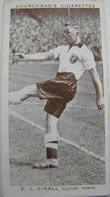 versions are often evident on the pitch. Publicity and marketing shots, however, invariably show short sleeved shirts and increasingly these are more commonly used in matches so, from 2009-10, HFK will use short sleeved templates to reflect this.
versions are often evident on the pitch. Publicity and marketing shots, however, invariably show short sleeved shirts and increasingly these are more commonly used in matches so, from 2009-10, HFK will use short sleeved templates to reflect this.
A little while ago Mark Hughesdon sent me this cigarette card from 1937-38 showing EJ Vinall playing for Luton Town. This prompted a serious exchange of emails with HFK's Research Associate, Simon Monks who invested time in the Luton Reference Library. No corroborating evidence can be found for the shirt shown in the card (only white collars were worn between 1937-39, when Vinall played for Luton) leading us to the conclusion that this image has been touched up. In the course of his research, Simon turned up a number of unrecorded kits, now added to the Luton Town gallery (1910-15, 1939-40, 1962-63 cold weather kit, 1964-65, 1965-66 alternate white kit all added; 1919-20 corrected and dates amended) while Mark provided evidence that the unique shirts worn in 1935-36 appeared at least once in the following season.
Dunfermline Athletic (2009-10 added): Sunderland (2009-10 added): Walsall (2009-10 added): Houston Dynamo (2009 kits now have the correct shade of "Space Blue" thanks to Dave Benedick): Corrections have been made to the stockings worn in FA Cup finals during the 1930s for Arsenal (1932), Manchester City (1933): Huddersfield Town (1938).
28 April: It's been an anxious four months for supporters of Burton Albion, who have watched their team squander a 19 point lead at the top of the National Conference and it was possible that they could have lost the title in the final round of matches at the weekend. Despite losing at Torquay United, they clinched the title when Cambridge Unted only managed a draw and will take their place in League Two next season.
Doncaster Rovers became the latest side to wear a charity kit when they turned out in green and white at the weekend. Darlington (1998-99 shorts corrected): Northampton Town (2009-2010 added): Bristol City (2009-10 added): Leicester City (2009-10 added): Blackpool (2009-10 added): Bury (1903 FA Cup final kit amended): the white kit worn by Aston Villa in their home match against West Ham has been added to the Premier League section.
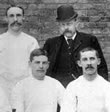 23 April: Steve Watson writes, "Why is it that early Blackburn Rovers kits are adorned with the England badge?" This led me to review the photographic evidence and I found the crest worn in an 1883-84 team photograph and again in one from 1890-91. Significantly, however, only a few of the players are wearing it while the majority are in plain shirts. The conclusion is that these were England internationalists who, in the fashion of the day, had the FA crest sewn onto their club jerseys - literally a badge of honour. (The crest has now been removed from the relevant graphics.) In the course of my research I came across this photograph of the FA Cup winning Rovers side of 1890, clearly showing them wearing the white dress shirts mentioned in yesterday's item.
23 April: Steve Watson writes, "Why is it that early Blackburn Rovers kits are adorned with the England badge?" This led me to review the photographic evidence and I found the crest worn in an 1883-84 team photograph and again in one from 1890-91. Significantly, however, only a few of the players are wearing it while the majority are in plain shirts. The conclusion is that these were England internationalists who, in the fashion of the day, had the FA crest sewn onto their club jerseys - literally a badge of honour. (The crest has now been removed from the relevant graphics.) In the course of my research I came across this photograph of the FA Cup winning Rovers side of 1890, clearly showing them wearing the white dress shirts mentioned in yesterday's item.
Colorado Rapids (2009 kits updated): Newcastle United (2009-10 added).
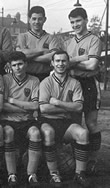 22 April: Our Watford section has benefitted from a good deal of input from historians and antiquarians and we can now add some detailed observations from Geoff Allen, a season ticket holder at The Vicarage who has kept personal records of the club's kits from the early 1960s to date, which include some interesting variations in the shade of their gold shirts. (1961-62, 1962-63, 1963-64, Aug 1965, 1973-74, 1978-79 added; 1964-68, 1968-71, 1972-73, 1974-76, 1976-78, 1983-85 detailing corrected). The photograph on the left is from 1959-60, the season that Watford switched from blue and white to gold and black. Going further back in time, there are indications that Watford wore turquoise shirts during the 1930s but to date I have found only circumstantial evidence to support this. Further information is welcome.
22 April: Our Watford section has benefitted from a good deal of input from historians and antiquarians and we can now add some detailed observations from Geoff Allen, a season ticket holder at The Vicarage who has kept personal records of the club's kits from the early 1960s to date, which include some interesting variations in the shade of their gold shirts. (1961-62, 1962-63, 1963-64, Aug 1965, 1973-74, 1978-79 added; 1964-68, 1968-71, 1972-73, 1974-76, 1976-78, 1983-85 detailing corrected). The photograph on the left is from 1959-60, the season that Watford switched from blue and white to gold and black. Going further back in time, there are indications that Watford wore turquoise shirts during the 1930s but to date I have found only circumstantial evidence to support this. Further information is welcome.
Jonathon Russell has sent HFK an interesting extract from Sir Frederick Wall's "50 Years of Football 1884-1934," which clarifies the colours worn in the 1882 FA Cup Final between Old Etonians and Blackburn Rovers. "...the match was lost when CW Alcock, the Secretary of the FA, wrote to the Rovers and pointed out the similarity of the colours of the clubs. The Etonians wore light-blue and white harlequin (ie halved) shirts. As the Rovers were usually attired in similar jerseys, the first thing they did on reaching London was to visit a big warehouse and take their own outfitter. The Rovers played in black and white stripes."
A similar situation arose in 1890 when Rovers were again in the final, this time against The Wednesday. According to The Knowledge (The Guardian, 4 March 2009), both teams arrived in London with their usual blue and white shirts. The problem was solved by a visit to a local tailor who supplied the Blackburn Rovers team with a set of eleven white, dress shirts. The Lancastrians went on to win 6-1. (Thanks to Chris Matterface for this snippet.)
Gillingham (August 1994 added - this kit was worn for only a few weeks): Preston NE (2009-10 added): Boston United (1993-96 corrected).
16 April: Pride of place today goes to this team photograph of Shrewsbury Town from 1935-36, one of several sent 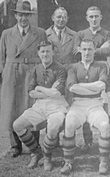 to HFK by Greger Lindberg, who has been contributing to HFK since the site was launched. The picture is interesting for two reasons: first of all the laced crew neck collars, which were by 1935 considered quite old-fashioned, feature a small contrasting diamond motif at the base. Secondly, the stockings are very clearly amber or gold with blue hoops. I believe that the traditonal colours of Shropshire are amber/gold and blue but until now, I had believed that the football club only adopted these colours in 1969. A photograph of the 1909-10 team now features on the Shrewsbury Town gallery along with several new graphics (1909-10, 1935-37, 1945-46, 1949-50 added; 1922-23, 1950-51, 1952-53 corrected).
to HFK by Greger Lindberg, who has been contributing to HFK since the site was launched. The picture is interesting for two reasons: first of all the laced crew neck collars, which were by 1935 considered quite old-fashioned, feature a small contrasting diamond motif at the base. Secondly, the stockings are very clearly amber or gold with blue hoops. I believe that the traditonal colours of Shropshire are amber/gold and blue but until now, I had believed that the football club only adopted these colours in 1969. A photograph of the 1909-10 team now features on the Shrewsbury Town gallery along with several new graphics (1909-10, 1935-37, 1945-46, 1949-50 added; 1922-23, 1950-51, 1952-53 corrected).
A number of clubs are currently consulting supporters over their choice of kit for next season, a trend that HFK warmly welcomes. A shame, therefore, that Crystal Palace fans are being offered a choice of bog standard Nike templates rather than the very individual designs Errea offered last season.
Updates from HFK's inbox: Southampton (1993-95 missing sponsor's logo added; dates for sponsorship in 1980 now correct): Newcastle United (1957-60, 1960-61 detailing amended): Sheffield Wednesday (2009-10 detailing amended): Celtic (1999-01 H, 1986-87 3rd corrected):
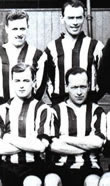 9 April: I recently stumbled across this fine team photograph of Southport FC in the online biography of George Harold Beadle on www.penmon.org, which is, incidentally, illustrated with graphics from HFK. Born in mid-Wales, Beadle played for Liverpool, Cardiff City, Sheffield Wednesday and Southport. He won two Welsh caps in the 1920s and would have had more had Liverpool not refused to release him, as he was needed to cover for players called up for England duty. He is seen here seated second from the left in the 1927-28 Southport team who are wearing striped shirts, which had been adopted that season. Previously the Sandgrounders' traditional colours had been red and white. (Click on the image to see the full team photograph).
9 April: I recently stumbled across this fine team photograph of Southport FC in the online biography of George Harold Beadle on www.penmon.org, which is, incidentally, illustrated with graphics from HFK. Born in mid-Wales, Beadle played for Liverpool, Cardiff City, Sheffield Wednesday and Southport. He won two Welsh caps in the 1920s and would have had more had Liverpool not refused to release him, as he was needed to cover for players called up for England duty. He is seen here seated second from the left in the 1927-28 Southport team who are wearing striped shirts, which had been adopted that season. Previously the Sandgrounders' traditional colours had been red and white. (Click on the image to see the full team photograph).
A number of additions have been made to the Derby County section: (1892, 1904-05, 1965-66, 1968-69 added). Curiously Derby also played in black and white stripes for the odd season between 1892 and 1923 rather than their familiar plain white shirts.
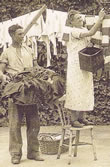 7 April: Here's a nice treat, sent to HFK by Pete Scully, showing the Tottenham Hotspur home and change kits being hung out to dry by Spurs' laundress prior to the start of the 1935-36 season. Note the hooped design of the change shirts.
7 April: Here's a nice treat, sent to HFK by Pete Scully, showing the Tottenham Hotspur home and change kits being hung out to dry by Spurs' laundress prior to the start of the 1935-36 season. Note the hooped design of the change shirts.
Falkirk's 1991-94 kit has been nominated for our Classic Kits collection and their 1996 effort has been consigned to Room 101. Jonny Dewart has sent in some new information of Northern Ireland's kits between 1969 and 2006, including details of the all-green kits worn against Scotland during the 70s and 80s. England will wear their traditional navy shorts when their new white ones clash with opponents - this kit has been added to the England gallery. Darlington (1996-97 corrected).
3 April: Steve Flanagan's research reveals the first occasion that Everton wore plain blue shirts at 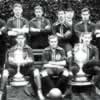 Goodison Park. It took place on 4 February 1893 when Nottingham Forest were the visitors for an FA Cup tie. At the time Everton wore (say it softly) ruby red (see photo left) so one of the teams had to change. The Liverpool Mercury reported the following Monday, "Everton wore new jerseys and their deep blue colour made a distinct and pretty contrast with the bright red of the Forest." While we're at it, Bren Frayne has found evidence that the chest band on the Toffee's 1958-61 change kit was gold and blue rather than black and blue as I'd previously thought.
Goodison Park. It took place on 4 February 1893 when Nottingham Forest were the visitors for an FA Cup tie. At the time Everton wore (say it softly) ruby red (see photo left) so one of the teams had to change. The Liverpool Mercury reported the following Monday, "Everton wore new jerseys and their deep blue colour made a distinct and pretty contrast with the bright red of the Forest." While we're at it, Bren Frayne has found evidence that the chest band on the Toffee's 1958-61 change kit was gold and blue rather than black and blue as I'd previously thought.
Newcastle United (1988-90, 1989-90, 1990-91, 1991-93 additional detail added to sponsor's logos on change kits): Dundee United (1959-60 added): Falkirk (1909-13, 1913-14 collar amended): Queens Park Rangers (2009-2010 added).
2 April: Last night England wore their new white strip with squad numbers and the South Africa 2010 sleeve patch for the World Cup qualifier with Ukraine. We also have some bits and bobs from HFK's inbox. Elgin City (1993-94 added): Ipswich Town (1982-84 added to Classic Kits and sponsor's logo corrected): Wales (1924 added - I've consolidated the original early galleries into one larger one covering 1872-1939).
 1 April: I've tweaked the England and Scotland galleries today so that the format is more consistent and added a few photographs to each. We also have a few additions and amendments: Ireland (1905 added): England (1932 added): Wales (1973 change shorts corrected): Scotland (1900, 1906 amended and 1994-96 now rendered with a more accurate version of the SFA tartan).
1 April: I've tweaked the England and Scotland galleries today so that the format is more consistent and added a few photographs to each. We also have a few additions and amendments: Ireland (1905 added): England (1932 added): Wales (1973 change shorts corrected): Scotland (1900, 1906 amended and 1994-96 now rendered with a more accurate version of the SFA tartan).
The two early Scottish graphics are variations on the wonderful Lord Roseberry colours, which were worn intermittently until the First World War (the version shown on the left dates from between 1905 and 1909). Now this is a kit that I would like to see revived when the SFA replace their third kit next year.
31 March 2008: I had a very long and enjoyable conversation yesterday with Simon Shakeshaft aka Shakey and as a result, have been able to add a considerable amount of detail to the Wales galleries from 1946 to date. In particular, all the missing change kits have now been added. Shakey is still looking for a number of rare items to add to his fine collection of match-worn Welsh international shirts which can be viewed on Walesmatchshirts.com where details of the shirts he is looking for will be found.
29 March: The new England kit, unveiled in yesterday's game with Slovakia, has been added. After a lengthy teaser 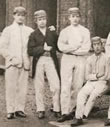 campaign, the new kit goes on sale tomorrow. (If you'd like to support our site you can buy the kit through the link on the England 1997-2010 gallery, earning HFK a small commission, which helps us meet our hosting costs.)
campaign, the new kit goes on sale tomorrow. (If you'd like to support our site you can buy the kit through the link on the England 1997-2010 gallery, earning HFK a small commission, which helps us meet our hosting costs.)
From the very latest in kit design let's turn to the very earliest. Peter Ferrette has sent HFK three rare photographs of Old Carthusians, the club formed by old boys of Charterhouse School. The picture on the upper left dates from 1863 and must be one of the very earliest team photographs in existence. Note that the team are wearing what are probably cricket whites and caps: there were no football kits at this time so teams would wear distinctive headgear and/or scarves to tell each other apart. Spectators were a minor inconvenience. The second photograph is from 1881 and could be the team that 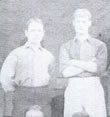 won the FA Cup that year, the first time the Old Carthusians had entered the competition. The halved shirts are typical of the era and I believe they were crimson and blue.
won the FA Cup that year, the first time the Old Carthusians had entered the competition. The halved shirts are typical of the era and I believe they were crimson and blue.
Steve Flanagan has uncovered two rare example of Everton wearing change kits in the 19th century. According to a report in the Liverpool Mercury 3 November 1890, "Everton donned a peculiar costume for the nonce (sic) of dark-blue jerseys with white fronts - a transformation from the salmon tint certainly." A month later the same newspaper reported, "Everton appeared in comfortable-looking dark jerseys of narrow blue and yellow stripes which contrasted strongly with those worn by Wolves which were of red and white tint."
Sheffield United (1922-23 added): Queens Park Rangers (1922-23 added): Huddersfield Town (2009-10 added): Hibernian (1989-91 shorts corrected, 2007-08 away kit corrected): Dunfermline Athletic (1990-92 manufacturer corrected): St Mirren (2008-09 stockings corrected): Rangers (2005-06, 2007-08 detailing added): Hearts (2006-07 stocking details corrected): Kilmarnock (1998-99, 2008-09 3rd corrected): Aberdeen (2008-09 missing stocking detail added): Celtic (2008-09 missing stocking detail added). The Scottish material was submitted by David Reynolds.
27 March: The Wales galleries have been posted in our International Section. As with everything on HFK, these 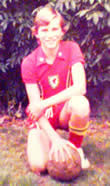 should be regarded as works in progress, presenting the best information we have to hand but always subject to improvement. I look forward to receiving additions, corrections and amendments, which, judging by the input we've received on our English, Scottish and Irish galleries will not be long in coming.
should be regarded as works in progress, presenting the best information we have to hand but always subject to improvement. I look forward to receiving additions, corrections and amendments, which, judging by the input we've received on our English, Scottish and Irish galleries will not be long in coming.
Which brings me to the proud young Welshman pictured in his brand new 1977 Admiral replica kit on the left, to whom HFK owes a considerable debt of gratitiude. Simon, aka Shakey has an unrivalled collection of match-worn Welsh international shirts that includes a very rare top from 1927-28 as well as example of most modern shirts, few of which appear to have been washed. These are featured on Walesmatchshirts.com along with helpful commentary. My enquiries through "official channels" while researching the International Section have generally met with indifference and it is individual enthusiasts like Shakey, Jonny Dewart, Glen Isherwood and Emmet Murphy that have enabled HFK to create such detailed archives.
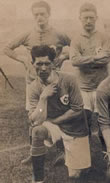 24 March: We have more today on the history of the Republic of Ireland. Jonny Dewart explains that the team photograph published here on 18 March is not in fact the Republic's 1921 junior side. The error stems from FAI 75 Years (1996), which incorrectly attributed the picture. Donal Cullen's Freestaters (2007) points out the error and confirms that the Irish did not field a junior team until 1927. The first team to represent the Irish Free State (as it was then called) was that which entered the 1924 Paris Olympics (pictured left courtesy of Irelandshirts.com) and played the United States in Ireland shortly afterwards. This team was organised by the Irish Olympic Committee: the first match under the auspices of the FA of the Irish Free State did not take place until 1926. I have also added the grey kit worn against Wales in 2007).
24 March: We have more today on the history of the Republic of Ireland. Jonny Dewart explains that the team photograph published here on 18 March is not in fact the Republic's 1921 junior side. The error stems from FAI 75 Years (1996), which incorrectly attributed the picture. Donal Cullen's Freestaters (2007) points out the error and confirms that the Irish did not field a junior team until 1927. The first team to represent the Irish Free State (as it was then called) was that which entered the 1924 Paris Olympics (pictured left courtesy of Irelandshirts.com) and played the United States in Ireland shortly afterwards. This team was organised by the Irish Olympic Committee: the first match under the auspices of the FA of the Irish Free State did not take place until 1926. I have also added the grey kit worn against Wales in 2007).
Sheffield Wednesday have released details of their kit for 2009-10, the first club to do so as far as I know.
St Johnstone (1977-79 corrected): Queens Park Rangers (minor adjustments made to kits between 1985 and 1991): Hartlepool United (2008-09 third kit has been released with different sponsorship to that shown in publicity photos): Hibernian (fine detailing added or amended on various kits 1987-2009 and 2008-09 Inter-Toto Cup kit added).
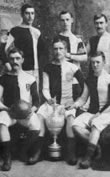 20 March: Peter Ferrette sent me this interesting photograph of Bolton Wanderers wearing hitherto unknown halved jerseys. The caption describes it as being from the "Early 1880s" and identifies the trophy as the Bolton Charity Cup. I contacted the club to see if they could help and within an hour received a reply from Simon Marland, the club secretary who confirmed the date as 1883. Wanderers wore all sorts of interesting strips around this time and it's a real pleasure to be able to add another one to the record.
20 March: Peter Ferrette sent me this interesting photograph of Bolton Wanderers wearing hitherto unknown halved jerseys. The caption describes it as being from the "Early 1880s" and identifies the trophy as the Bolton Charity Cup. I contacted the club to see if they could help and within an hour received a reply from Simon Marland, the club secretary who confirmed the date as 1883. Wanderers wore all sorts of interesting strips around this time and it's a real pleasure to be able to add another one to the record.
Other additions and updates include Scotland (new 2009 change kit added); Derby County (all-yellow variant on current change kit added); Rochdale (1985-86, 1986-87, 1987-88 collar detailing corrected).
 19 March: We have a few more updates for Luton Town today (1905-10 amended and dates extended; 1937-38 added; 2005-07 collar detailing added). The photograph, sent in by Mark Hughesdon, is of the 1909-10 team (helpfully, teams would paint the season onto the ball which was always held by or placed in front of the captain). Although the quality of the photo is a bit ropy, it is possible to see that the shirts are slightly darker than the shorts. Luton in fact wore sky blue at the time, a colour adopted in 1901 and retained until 1920, when they changed to white shirts and black shorts.
19 March: We have a few more updates for Luton Town today (1905-10 amended and dates extended; 1937-38 added; 2005-07 collar detailing added). The photograph, sent in by Mark Hughesdon, is of the 1909-10 team (helpfully, teams would paint the season onto the ball which was always held by or placed in front of the captain). Although the quality of the photo is a bit ropy, it is possible to see that the shirts are slightly darker than the shorts. Luton in fact wore sky blue at the time, a colour adopted in 1901 and retained until 1920, when they changed to white shirts and black shorts.
Judging from material submitted by John Heron and Johnny Dewart, the blue shirts worn by Ireland prior to 1931 were considerably lighter than I had previously thought. These have now been amended and graphics of the 1882 and 1914 kits added. Alan McCabe writes about Scotland wearing an unexpected combination in a World Cup Qualifier in Berne on 19 May 1957: With the game being transmitted live on TV, remembering these were pioneering days for (live TV) the red and white of Switzerland and navy and white of the visitors were not considered different enough to make viewing easy. Scotland...were expected to change but had brought no alternate kit. The problem was solved when the Swiss loaned a set of orange shorts (to) the Scots who proceeded to win 2-1 bedecked in this most unusual of combinations.
More updates from HFK's Inbox: Sheffield United (1987-88 stripes modified): Manchester United (2009 kit with FIFA World Club Championship badge added): East Fife's 1998 kit has been nominated for Room 101.
18 March: The Republic of Ireland section has been posted in our Home International section. Now I appreciate 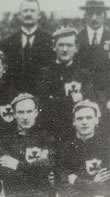 that Ireland are not one of the home nations but their history is so closely linked to that of the all-Ireland team that played prior to 1921 and so entangled with that of Northern Ireland that it is impossible to tell the story of the one without the other. My prime resource for this new section is Emmet Murphy's exceptional Irelandshirts.com site. Emmet has not only published photographs that illustrate Ireland's kits since 1921, he has also posted photographs of his personal collection of match-worn Ireland shirts that is second to none.
that Ireland are not one of the home nations but their history is so closely linked to that of the all-Ireland team that played prior to 1921 and so entangled with that of Northern Ireland that it is impossible to tell the story of the one without the other. My prime resource for this new section is Emmet Murphy's exceptional Irelandshirts.com site. Emmet has not only published photographs that illustrate Ireland's kits since 1921, he has also posted photographs of his personal collection of match-worn Ireland shirts that is second to none.
Today's featured picture is from Emmet's site and shows the 1921 Irish Free State Junior team prior to a match with Scotland Juniors and is the first Irish represenative side to have played after the split with the Irish FA. Shortly afterwards the home associations boycotted the new FA of Ireland and there was no further contact until after the Second World War. Note the similarity of the kit to that of the 1909 all-Ireland junior team featured on 6 March. In 1924 an Irish free State team played in the Paris Olympics but it was not until 1926 that the FA of the Irish Free State organised what is now regarded as the first official international fixture.
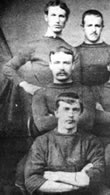 11 March: Christian Larsen recently sent in details of the SAFC Photo Archive, a collection of team and action photographs of Sunderland going back to the nineteenth century and which has helped me fill in a few gaps. The featured picture shows the 1884 team wearing blue - this was the season that they won their first trophy, the Durham Senior Cup. The familiar red and white stripes were introduced two years later.
11 March: Christian Larsen recently sent in details of the SAFC Photo Archive, a collection of team and action photographs of Sunderland going back to the nineteenth century and which has helped me fill in a few gaps. The featured picture shows the 1884 team wearing blue - this was the season that they won their first trophy, the Durham Senior Cup. The familiar red and white stripes were introduced two years later.
Jonathon Russell has turned up some fascinating information about Blackburn Rovers' first colours. According to the 1905 Book of Football there exists a minute book which dates the first meeting as 5 November 1875 with the first resolution being "That this club be called Blackburn Rovers." (A later meeting records) "That the colours be white jersey, blue and white skull cap, trousers optional," and later still "That a Maltese cross be worn on the left breast." A link with both Malvern and Shrewsbury public schools and Rovers' early shirts was already known to HFK but we now know that it was the Maltese Cross motif, which was worn by the football teams from both schools, that forms the connection. Rovers were founded by two former Shrewsbury schoolboys and included two old Malvernians in their first team.
Tottenham Hotspur (1982-83 3rd kit added): East Fife (new home shirt sponsorship added):
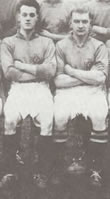 10 March: No sooner was the new Northern Ireland section posted on HFK than Jonny Dewart, editor of the NIFG site, got in touch with an offer to fill in some of the substantial gaps in our records. In particular, I've now been able to identify the team featured below on 6 March as the Irish Junior side, who wore the single shamrock badge while the senior team wore a crest combining the Irish harp with a Celtic cross. I have also learned that the Irish amateur team wore green tops and that the seniors probably borrowed these when required to change for their matches with Scotland.
10 March: No sooner was the new Northern Ireland section posted on HFK than Jonny Dewart, editor of the NIFG site, got in touch with an offer to fill in some of the substantial gaps in our records. In particular, I've now been able to identify the team featured below on 6 March as the Irish Junior side, who wore the single shamrock badge while the senior team wore a crest combining the Irish harp with a Celtic cross. I have also learned that the Irish amateur team wore green tops and that the seniors probably borrowed these when required to change for their matches with Scotland.
Among the material sent to HFK by Jonny are these two photographs of the national side, which was still known as "Ireland" at the time. The first is of the 1930 side lining up before the game with Wales, wearing their old blue shirts with the harp crest. The second picture was taken the following year, in 1931 before the return fixture. The Irish players are now wearing brand new green tops with a shamrock crest. Officially the switch was made to avoid the need to change against Scotland but many believe the rivalry with the FA of the Irish Free State was behind the change. Both associations claimed to represent the whole of Ireland at the time and the adoption of the colours and crest worn by 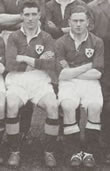 the team from the south by the Belfast-based IFA appears to be a deliberate attempt to co-opt the identity of the former.
the team from the south by the Belfast-based IFA appears to be a deliberate attempt to co-opt the identity of the former.
Sheffield Wednesday (1987-88, 1988-89 amended): Scotland (variants worn against Hungary in 1954 and Wales in 1966 added):
I received an interesting mail from Curtis McArdle recently concerning Tranmere Rovers switch from blue shirts to all-white in 1962, which prompted me to have a look back through HFK's records. There was a vogue for plain white kits in the early and mid 1960s: these looked particularly good under floodlights which became universally available during this period. Tranmere, Bradford PA, Exeter, Brighton, Crystal Palace, Scunthorpe, Walsall, York, Doncaster, Port Vale and of course Leeds all dropped traditional outfits for all-white. Although white has always been the traditional strip of Swansea Town/City, I checked back through my records to see who were the first to adopt the kit in modern times. It was in fact Coventry City who switched from their traditional blue and white shirts in 1959 and a few years later adopted all-sky-blue, another ground-breaking strip.
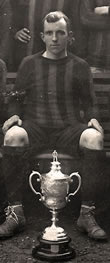 8 March: The gentleman pictured today is the spendidly named Robert Moscrop Wardaugh, captain of Vale of Dryfe FC and was sent to HFK by Mac Creedon, his grandson. The picture was taken around 1900, probably in the courtyard of the Townhead Hotel in the team's home town of Lockerbie. The trophy on display has not been identified but would almost certainly be for one of the many knock-out cup competitions that existed at this time in the south-west of Scotland. Regular league competition proved difficult to organise among the small, scattered communities in the region so teams organised friendly matches and participated in knock-out competitions instead.
8 March: The gentleman pictured today is the spendidly named Robert Moscrop Wardaugh, captain of Vale of Dryfe FC and was sent to HFK by Mac Creedon, his grandson. The picture was taken around 1900, probably in the courtyard of the Townhead Hotel in the team's home town of Lockerbie. The trophy on display has not been identified but would almost certainly be for one of the many knock-out cup competitions that existed at this time in the south-west of Scotland. Regular league competition proved difficult to organise among the small, scattered communities in the region so teams organised friendly matches and participated in knock-out competitions instead.
Vale of Dryfe were formed in 1896 and wound up in 1906. The committee then formed a new club, Mid-Annandale, which competed as a junior club until 1910 when they returned to senior football, before joining the ill-fated Scottish Third Division between 1923 and 1926.
More today from Mark Hughesdon, who has obviously been bitten by the HFK bug and has been trawling through his programme collection to send us more details on Luton Town's kits: (1992-93 added; 1993-94, 1994-95 corrected; a more accurate badge now appears on the 1934-1947 graphics). Tim Davis has also corrected the 1995-97 kit. Leicester City (2008-09 alternate home kit added).
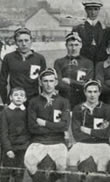 6 March: Taken on October 16, 1909, this photograph shows the Ireland team before a match with a Lanarkshire XI. It may not be the first team of the Irish FA at the time but it does give us some interesting clues about what the Irish team wore in this period. First of all, note the caps - these guys were internationals. A second thing to note is the crest - a large shamrock on a white shield. The only records I have found of the IFA crest date from after the First World War, when a gold celtic cross combined with an Irish harp was worn on players' shirts.
6 March: Taken on October 16, 1909, this photograph shows the Ireland team before a match with a Lanarkshire XI. It may not be the first team of the Irish FA at the time but it does give us some interesting clues about what the Irish team wore in this period. First of all, note the caps - these guys were internationals. A second thing to note is the crest - a large shamrock on a white shield. The only records I have found of the IFA crest date from after the First World War, when a gold celtic cross combined with an Irish harp was worn on players' shirts.
At this time the Irish team wore blue shirts: the colour associated with Ireland since Norman times was "St Patrick's blue." I believe that the association with green was a creation of 19th century Irish nationalists who sought to create an Irish identity separate from that of the English occupiers and their Norman antecedants. In 1921 the Irish FA split and the Dublin clubs formed their own association a year before the partition of Ireland and the creation of the Irish Free State. The new association was recognised by FIFA and entered a football team in the 1924 Olympics wearing green shirts. The IFA team continued to wear blue until 1931 when they also adopted green.
The history of Ireland/Northern Ireland's kits is now available in our International Section. Please mind your head as you enter and place chiildren in the receptacles provided. A history of the Republic's kits will be available shortly.
5 March: Sheffield Wednesday (1995-97, 1997-99 correct badges applied): Newcastle United (1995-97 change kit amended): Cowdenbeath (2001-02 added): St Johnstone (1980-82 badge corrected): Luton Town (1991-92, 1992-94, 1994-95, 1995-97, 1997-99 sponsor's logo amended; Littlewoods' Cup commemorative script added to 1988-89 kits): Aston Villa two (alternate change kits added): Doncaster Rovers (alternate home kit added).
4 March: New Feature! In two weeks time the 2009 season in the United States kicks off (referred to in the States as "First Kick"). Due to growing interest on both sides of the Atlantic, HFK is delighted to announce the launch of our brand new Major League Soccer gallery. Enjoy.
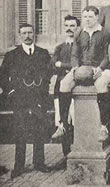 Daniel Galoto of Buenos Aires has sent us this fine photograph of Nottingham Forest taken when they visited Argentina as part of their South American tour in the summer of 1905, which was very influential in the development of the game in that continent. Daniel notes that the some of the players' shirts have white cuffs while others are red. (Another picture taken on the same tour is presented on the Nottingham Forest page and shows red cuffs on everyone's shirt). Such variations were not unusual at this time. The famous CA Independiente of Avallaneda, formed in January 1905 adopted Nottingham Forest's red shirts in 1907 and play in these colours to this day.
Daniel Galoto of Buenos Aires has sent us this fine photograph of Nottingham Forest taken when they visited Argentina as part of their South American tour in the summer of 1905, which was very influential in the development of the game in that continent. Daniel notes that the some of the players' shirts have white cuffs while others are red. (Another picture taken on the same tour is presented on the Nottingham Forest page and shows red cuffs on everyone's shirt). Such variations were not unusual at this time. The famous CA Independiente of Avallaneda, formed in January 1905 adopted Nottingham Forest's red shirts in 1907 and play in these colours to this day.
The all-white kit worn by Aston Villa in their UEFA Cup tie with CSKA Moscow has been added to the 2008-09 Premier League gallery. Manchester United (1974-75 third kit added).
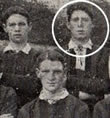 3 March: As St David's Day has just passed it seems appropriate to feature two clubs from South Wales that played in the Football League in former times. Betty Tully has sent in some fine old photographs of the Merthyr Town team from the early part of the twentieth century from her 91 year-old father's personal collection. The featured picture shows Betty's grandfather, Danny Simons (circled) with the 1909 team. Click the thumbnail to view the full line-up as written on the reverse of the original. (Back row L-R); Barlow, Jones, Simons, Ward, Lewis, Alden, Capel, (Middle Row L-R); Oates?, Minsey (?), Savage, Spriggs, Walton, Holmes, Churchill, Collins, (Front Row L-R); Tudor, Laycock?, Taylor. You can see more of Betty's collection on the excellent Old Merthyr Tydfil website.
3 March: As St David's Day has just passed it seems appropriate to feature two clubs from South Wales that played in the Football League in former times. Betty Tully has sent in some fine old photographs of the Merthyr Town team from the early part of the twentieth century from her 91 year-old father's personal collection. The featured picture shows Betty's grandfather, Danny Simons (circled) with the 1909 team. Click the thumbnail to view the full line-up as written on the reverse of the original. (Back row L-R); Barlow, Jones, Simons, Ward, Lewis, Alden, Capel, (Middle Row L-R); Oates?, Minsey (?), Savage, Spriggs, Walton, Holmes, Churchill, Collins, (Front Row L-R); Tudor, Laycock?, Taylor. You can see more of Betty's collection on the excellent Old Merthyr Tydfil website.
I'm also grateful to Gareth Protheroe who has trawled through his collection of Aberdare Athletic 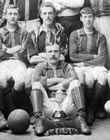 memorabilia to fill in some of the gaps in HFK's records. Our photograph, which comes from the collection at Rhondda Cynon Taff Library Services shows the 1899-1900 team with an unidentified trophy.
memorabilia to fill in some of the gaps in HFK's records. Our photograph, which comes from the collection at Rhondda Cynon Taff Library Services shows the 1899-1900 team with an unidentified trophy.
In this part of South Wales, every town and village has its own rugby club and both Merthyr and Aberdare struggled to attract sufficient support. The Great Depression and the Miners' Strikes of the mid-1920s hit attendances hard (attempts to reduce admission prices for the unemployed were thwarted by the league authorities). Both teams fell into a vicious spiral, selling off their best players and replacing professionals with part-timers and amateurs to reduce their outgoings. As playing standards fell, so did attendances and it became impossible to make ends meet. Aberdare lost their place in the Football League in 1927 and went out of business the following year. Merthyr failed re-election in 1930 but held on in the Southern League until 1934 when they too were wound up.
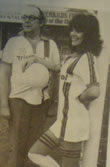 Mark Hughesdon has sent in this interesting cutting from the Luton Town matchday programme of 1 March 1980. On the left is Eric Morecambe, Luton's most famous celebrity supporter clowning around with model Jackie Jones at the launch of the Hatters new sponsored shirts. At the time shirt sponsorship was still a novelty, Luton being only the ninth club to have secured a deal. To view the full article click the thumbnail (Caution - large file not suitable for slow connections.)
Mark Hughesdon has sent in this interesting cutting from the Luton Town matchday programme of 1 March 1980. On the left is Eric Morecambe, Luton's most famous celebrity supporter clowning around with model Jackie Jones at the launch of the Hatters new sponsored shirts. At the time shirt sponsorship was still a novelty, Luton being only the ninth club to have secured a deal. To view the full article click the thumbnail (Caution - large file not suitable for slow connections.)
Miscellaneous updates: Bolton Wanderers (2008-09 alternate all-white kit added): Middlesbrough (1909-10 added): Southend United (1961-65, 1965-67, 1967-68 corrected. The Shrimpers wore navy shirts for part of the 1968-69 season before being instructed to change because these clashed with the black referees' outfits. After borrowing shirts from Chelsea, Coventry and Ipswich the supporters voted to keep the set provided by West Bromwich Albion. Thanks to Jack Bond for this information. Singers FC (1883-91, 1891-98 corrected - a photograph of the 1891 team now appears on the Coventry City page).
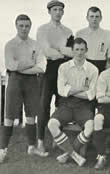 26 February: Today, thanks to Dick Waite, we can confirm that the early England team wore their club stockings. The first photograph of the 1905 team that played Wales shows this very clearly. Players were also expected to provide their own navy knickers, as this letter from the David France Collection to Everton international, Harold Hardman from the FA dated 23 October 1906 confirms:
26 February: Today, thanks to Dick Waite, we can confirm that the early England team wore their club stockings. The first photograph of the 1905 team that played Wales shows this very clearly. Players were also expected to provide their own navy knickers, as this letter from the David France Collection to Everton international, Harold Hardman from the FA dated 23 October 1906 confirms:
England v France
Towards the end of the week a white flannel shirt will be sent to you which will be for use in this match. Will you kindly put it in your portmanteau. It is thought convenient to send the shirts to each member rather than run the risk in sending them across to Paris. As mentioned in my letter of the 16th October the players will please play in blue knickers. (p42 Dr Everton's Magnificent Obsession - France & Prentice 2008)
The practice continued until the 1930s. The second composite picture shows Ernie Blenkinsop shaking hands with Spanish goalkeeper, Zamora, before the international on 9 December 1931 alongside Dixie Dean challenging Zamora in the same match. Dean is wearing a pair of Everton socks and a white stripe down the side of his knickers. Everton had just introduced this trim and it looks like Dean took a pair of his club's change shorts to the game.
The first evidence we have of the England team wearing matching stockings comes from the infamous "Battle of Highbury" against Italy in November 1934. Here we see the England team lined up before
the kick-off, with Eddie Hapgood introducing the team to Arthur, Prince of Connaught and the Italian Ambassador. The pristine state of the stockings suggests that they were brand new and bought for the occasion, which was Italy's first match after they became World Champions.
Glen Isherwood of England Football Online has supplied a good deal of additional detailing information that has been added to the post war England and Scotland galleries.
England: 1934, 1958 World Cup Finals, June 1963 added. Various amendments to detailing made on kits 1946-65.
Scotland: 1974 British Championship kit added; 1978 v N Ireland amended.
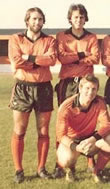 25 February: You may notice among the attributions on our club pages the term "HFK Research Associate." This accolade is awarded to correspondents who are experts on their club and to whom HFK turns when a question arises. Ade Williams, official historian to Newport County and our most recent inductee has written with information that clarifies some fine detailing on the original Newport's kits 1974-1988. Today's photograph shows the team from 1978-79, one of the seasons that they wore tangerine rather than the more familiar amber.
25 February: You may notice among the attributions on our club pages the term "HFK Research Associate." This accolade is awarded to correspondents who are experts on their club and to whom HFK turns when a question arises. Ade Williams, official historian to Newport County and our most recent inductee has written with information that clarifies some fine detailing on the original Newport's kits 1974-1988. Today's photograph shows the team from 1978-79, one of the seasons that they wore tangerine rather than the more familiar amber.
Thanks to regular contributors Glen Isherwood and Christopher Worrall, we've made some additions to the Scotland international gallery. (1971, 1973, 1976-77 alternate kits added; missing horizontal shadow stripes added to 1998 kits, minor changes to 1999-00, 1996-98, 1986-88 & 1985-88 change kits). A fine stripe has been added to England's shorts 1980-83 and the 1985 shirt worn against the US has been amended.
Manchester United (1986-88 3rd kit amended): Arsenal (1957-60, 1961-62 cuffs corrected): Everton (1952-53 change kit added):
15 February: For their FA Cup tie with Fulham, played yesterday, Swansea City wore shirts sponsored by Paddy Power, the on-line betting company. While the Irish bookmakers receive the publicity of national TV coverage, the club are auctioning off the match-worn shirts, signed by the players to raise money for NSPCC Cymru/Wales. The full story is available on the club website. Oldham Athletic will also wear a one-off kit when they play Leeds United on 2 March, a stunning all-pink outfit with proceeds going to support the Breast Cancer Unit at the Royal Oldham Hospital.
Aldenham School, Hackney Black Rovers, Mackenzie and Norfolk have been added to the Eminent Victorians gallery.
Wimbledon (1982-83 added): Airdrieonians (2000-01 badge corrected): Wolves (1989-90 added - a very slight variation on the previous season's kit).
13 February: I'd like to draw the excellent EFC History website to your attention, mainly because of the fine 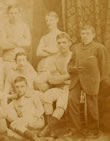 collection of Everton photographs including this one from 1881, the earliest known picture of the team, who are wearing pink and white shirts. Drawn from the remarkable collection of David France, these are among the tens of thousands of treasures David has gathered over 25 years and include handwritten ledgers recording the formal minutes of the club's weekly board meetings between October 1887 and July 1964 and an almost complete set of match programmes for the period 1886 to 2002. I was very pleased to hear from David a while ago and delighted to receive from him a copy of Dr Everton's Magnificent Obsession, (ISBN 978 190 5266 791), an entertaining and well-illustrated introduction to the collection that I recommend to everyone interested in the history of association football. This extraordinary collection has now been aquired by the Everton Collection Charitable Trust in order to preserve it intact for future generations of Everton Fans.
collection of Everton photographs including this one from 1881, the earliest known picture of the team, who are wearing pink and white shirts. Drawn from the remarkable collection of David France, these are among the tens of thousands of treasures David has gathered over 25 years and include handwritten ledgers recording the formal minutes of the club's weekly board meetings between October 1887 and July 1964 and an almost complete set of match programmes for the period 1886 to 2002. I was very pleased to hear from David a while ago and delighted to receive from him a copy of Dr Everton's Magnificent Obsession, (ISBN 978 190 5266 791), an entertaining and well-illustrated introduction to the collection that I recommend to everyone interested in the history of association football. This extraordinary collection has now been aquired by the Everton Collection Charitable Trust in order to preserve it intact for future generations of Everton Fans.
From these resources I have been able to add a number of missing kits to the Everton archive (1902-03 change, 1907-08, 1914-15, 1920-21, 1934-35, 1935-36 change, 1946-47, 1954-55).
Other updates: Celtic (1991-92 A, 1992-93, 1992-93 A, 1993-94 A, 2001-02 A detailing amended): Forfar Athletic (1980-82, 1982-83, 1983-84, 1984-86, 1986-87, 1988-89 detailing amended and missing manufacturers' details added): Aberdeen (2004-05 detailing amended): Huddersfield Town (1986-87 corrected, 1994-95, 1999-2001 details amended): Chelsea (1981-83 H, 1993-94 3rd - the correct pattern of pinstripes has been applied).
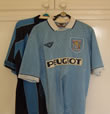 Yesterday I discussed the challenge of interpreting black and white images from the the first 25 years of the last century and you might think that colour photography would have made our job at HFK simpler but this is not entirely true. "Sky blue," for example is extremely hard to define. First of all, manufacturers are more prepared to vary the shade than they are with standard reds and blues. Secondly, lighting conditions and exposure times can have a dramatic effect on the final image. In these circumstances it is very helpful indeed to have input from someone like Phil Arnold, a season ticket holder at Coventry City with an impressive collection of replica shirts. Thanks to Phil I have made some adjustments to various Coventry kits between 1986 and 2007. Illustrated are the 1994-96 (front) and 1997-98 tops from Phil's collection, to illustrate how hues can vary.
Yesterday I discussed the challenge of interpreting black and white images from the the first 25 years of the last century and you might think that colour photography would have made our job at HFK simpler but this is not entirely true. "Sky blue," for example is extremely hard to define. First of all, manufacturers are more prepared to vary the shade than they are with standard reds and blues. Secondly, lighting conditions and exposure times can have a dramatic effect on the final image. In these circumstances it is very helpful indeed to have input from someone like Phil Arnold, a season ticket holder at Coventry City with an impressive collection of replica shirts. Thanks to Phil I have made some adjustments to various Coventry kits between 1986 and 2007. Illustrated are the 1994-96 (front) and 1997-98 tops from Phil's collection, to illustrate how hues can vary.
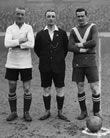 10 February: Today I'm going to focus on material that illustrates the variations in colour shade that existed in the Victorian period and the first 25 years or so of the twentieth century. Naturally colour photography was not available so we have to rely on interpreting monochrome photographs and written records. We also know that there was some variation in dye shades between different manufacturers and that, as these were mainly sourced from Germany, alternatives had to be produced in the UK after 1914, which implies further variation in shade between the pre- and post-war periods.
10 February: Today I'm going to focus on material that illustrates the variations in colour shade that existed in the Victorian period and the first 25 years or so of the twentieth century. Naturally colour photography was not available so we have to rely on interpreting monochrome photographs and written records. We also know that there was some variation in dye shades between different manufacturers and that, as these were mainly sourced from Germany, alternatives had to be produced in the UK after 1914, which implies further variation in shade between the pre- and post-war periods.
The first photograph shows the captains of Birmingham and Spurs before their match on Boxing Day 1925. Birmingham are wearing a hitherto un-recorded all-blue strip that is slightly lighter than the navy blue of Spur's shorts.
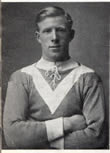 The second image is also of a Birmingham player but dates from before the First World War. The distinctive V is rather less deep than the post-war version and we have a large, lace up round collar. The shirt is without doubt lighter than the post-war version even allowing for the lack of points of reference such as the referee's black knickers in the 1925 image. The pristine condition of the shirt precludes any suggestion that the paler shade is due to fading after washing.
The second image is also of a Birmingham player but dates from before the First World War. The distinctive V is rather less deep than the post-war version and we have a large, lace up round collar. The shirt is without doubt lighter than the post-war version even allowing for the lack of points of reference such as the referee's black knickers in the 1925 image. The pristine condition of the shirt precludes any suggestion that the paler shade is due to fading after washing.
A photograph from 1905 reproduced on the Birmingham club page shows the team in plain tops of a similar shade and very dark (navy or black) stockings. Officially the club's colours were "light blue and white" in 1905 and "blue" or "royal blue and white" from 1913 but I am now inclined to think that the team played in a shade of mid-blue between 1893 and 1915. After the Great War a darker shade was used before the familiar royal blue shirts appeared in the late 1920s.
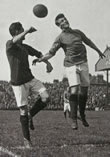 Our next example features a pre-season match between Arsenal's first and reserve teams from August 1925. (Even though this was a practice game, the terraces are filled with spectators.) The first team are wearing the dark red shirts of the period while the reserves are in lighter tops, which I believe were mid-blue and were probably the official change colours of the time. These featured on HFK on 9 January 2009, when we revealed that matching shorts were worn in 1919.
Our next example features a pre-season match between Arsenal's first and reserve teams from August 1925. (Even though this was a practice game, the terraces are filled with spectators.) The first team are wearing the dark red shirts of the period while the reserves are in lighter tops, which I believe were mid-blue and were probably the official change colours of the time. These featured on HFK on 9 January 2009, when we revealed that matching shorts were worn in 1919.
Warning: the full scale version of this photograph includes coarse language that may offend.
Finally let's examine how Blackburn Rovers' colours evolved in the first fifty years of their existence. The club has always described its colours simply as "blue and white." The proper description of their shirts is "halved" but, perhaps because the Rover's tops were always reversed on the back, the club always described them as "quartered." Blue might appear on either side (manufacturers were 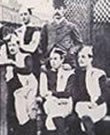 less fussy about consistency in those days) and the early team photographs show players wearing both right and left handed versions.
less fussy about consistency in those days) and the early team photographs show players wearing both right and left handed versions.
The earliest photograph we have is from 1878, taken only three years after the club's formation. Even allowing for the quirks of Victorian photography, the halves are evidently very dark indeed. The key here is to examine the contrast between the players' shirts and the suited gentleman standing at the back. (Note the cowls worn by the players; distinctive headgear was very much part of a team's uniform in those days.)
During the club's heyday in the 1880s, the teams' shirts were very pale and, unlike the 1878 photograph, it is quite 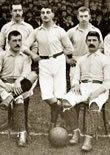 hard to distinguish the halves. Some images of the great FA Cup winnings sides are badly over-exposed but there are so many photographs of the team from this period that we can be confident that the shirts were in pale Cambridge blue and white. The photograph on the left was taken in 1895 and is one of the clearest we have from this era. We do not have the benefit of non-players in the foreground to establish contrast but we can compare the shirts with the general background and foreground details.
hard to distinguish the halves. Some images of the great FA Cup winnings sides are badly over-exposed but there are so many photographs of the team from this period that we can be confident that the shirts were in pale Cambridge blue and white. The photograph on the left was taken in 1895 and is one of the clearest we have from this era. We do not have the benefit of non-players in the foreground to establish contrast but we can compare the shirts with the general background and foreground details.
Sometime around the turn of the century the blue became considerably richer. Contrast the 1895 photograph with the one below, which is of the 1904-05 side. Again we have to use the background to establish our points of reference and allow for the fact that the team are wearing dark (black or navy) knickers. The shade seems to me to be part way between sky and mid blue similar to the Birmingham photograph from 1913 featured above. The photographic evidence suggests 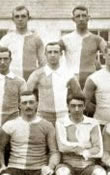 that this intermediate colour was used until the late 1920s.
that this intermediate colour was used until the late 1920s.
During the 1930s a conventional shade of mid blue was adopted and the blue half appeared on the left side of the shirt, where it has remained ever since. Light blue was reintroduced in 1986, at first as the main colour of the stockings and between 1990 and 1992 on the shirts themselves, a conscious reference to the club's early colours.
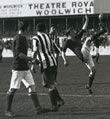 9 February: Technical problems have prevented us from updating the site over the past fortnight but these have now been resolved and, as usual when we take an extended break, HFK's in-box is stuffed with new contributions. We'll start with this intriguing photograph from the Arsenal Stadium History, submitted by Dick Waite, showing a league game between Woolwich Arsenal and Liverpool on 2 September 1911. Arsenal's dark red shirts are shown to good effect while the visitors are playing in unfamiliar stripes. Note the natty outfit worn by the referee (click on the thumbnail to view the full picture).
9 February: Technical problems have prevented us from updating the site over the past fortnight but these have now been resolved and, as usual when we take an extended break, HFK's in-box is stuffed with new contributions. We'll start with this intriguing photograph from the Arsenal Stadium History, submitted by Dick Waite, showing a league game between Woolwich Arsenal and Liverpool on 2 September 1911. Arsenal's dark red shirts are shown to good effect while the visitors are playing in unfamiliar stripes. Note the natty outfit worn by the referee (click on the thumbnail to view the full picture).
Dick's second contribution is rather more difficult to interpret. Taken on 10 March 1906 at Bank Street, Woolwich Arsenal are playing Manchester United in the FA Cup. The rules of the competition required both 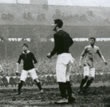 teams to change when colours clashed but as most teams wore white change shirts, it was not unusual for unique shirts to appear in these games, bought or borrowed for the occasion. This may be the case here. If you can help HFK interpret this picture please get in touch. Incidentally, if you look closely you will notice spectators sitting precariously on the roof of the stands.
teams to change when colours clashed but as most teams wore white change shirts, it was not unusual for unique shirts to appear in these games, bought or borrowed for the occasion. This may be the case here. If you can help HFK interpret this picture please get in touch. Incidentally, if you look closely you will notice spectators sitting precariously on the roof of the stands.
From the same era, Pete Wyatt has found evidence that Stoke wore white shirts and black knickers for the 1903-04 season, although their regular claret shirts were retained as a change kit and were probably reinstated the following season.
Chelsea (1970-71 European Cup Winners's Cup change kit added): Dundee United (1991-92, 2005-06 special added; 1989-91, 1992-93, 1993-94, 1994-96, 1996-97, 1997-98, 2000-01 missing detailing and 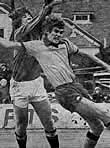 manufacturer information added; 2006-08 short sponsor added). Wolves (1965-69, 1988-90 kits amended). Stuart Davis, who contributed the 1988-90 details recalls that the replicas on sale to the public had iron-on plastic badges that broke up after a few washes. The club offered replacements which could be applied over the ruined original (Stuart eventually had five, one on top of the other). Limited editions were produced with woven badges which are now highly collectible.
manufacturer information added; 2006-08 short sponsor added). Wolves (1965-69, 1988-90 kits amended). Stuart Davis, who contributed the 1988-90 details recalls that the replicas on sale to the public had iron-on plastic badges that broke up after a few washes. The club offered replacements which could be applied over the ruined original (Stuart eventually had five, one on top of the other). Limited editions were produced with woven badges which are now highly collectible.
Willie Kay, HFK's Motherwell Research Associate has uncovered these interesting items from the 1978-79 season. The top picture shows Motherwell playing Hearts in the first part of the season wearing their new Admiral shirts with two vertical claret stripes down the left hand side. The second picture was taken on 10 February 1979 before the home game with Hibs and clearly shows the team captain 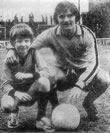 wearing the previous season's shirt with claret shorts and socks. Additional photographs confirm that the old shirts were worn until the end of the season. The reasons for this change remain unknown.
wearing the previous season's shirt with claret shorts and socks. Additional photographs confirm that the old shirts were worn until the end of the season. The reasons for this change remain unknown.
Willie has also confirmed that Scotland wore plain white shirts when colours clashed in the 1930s.
Leicester City's home tops for 2009-2010 will not carry any sponsorship, following a consultation with supporters that overwhelmingly came out in favour of blank shirts to mark the club's 125th anniversary. The club are now inviting applications from regional charities with a view to carrying a charitable logo on their away kit next season.
Manchester United (1984-86 3rd, 1984-85 A stockings amended).
A number of alternate kits for the current season have appeared recently. Luton Town orange third kit, Cardiff City all-yellow third kit, Aston Villa alternate home kit. Match officials seem to be going to ridiculous lengths this season to avoid any suggestion of a colour clash. Brighton were forced to wear Leicester's yellow third kit last month because the referee thought their navy and yellow change shirts were too similar to the home side's plain royal blue. Birmingham had to dig out last season's all-red third kit when they visited Sheffield Wednesday recently.
25 January: Scotland have been added to the International Section.
23 January: Last year, when I was preparing artwork for the new edition of the Rangers Miscellany, the  author Robert MacElroy wrote, "All blue kits from 1870-80 to 1920-21 need to be a much lighter blue. Similar to Man City or Marseille." Recently, however, Sandy Jardine (former Scottish international and now Rangers' Heritage Officer) and David Mason (the club's historian) have been researching the club's early records and minute books and have confirmed that the shirts were consistently described as "royal blue" throughout their history. As a result, I have revised the Rangers gallery. The photograph on the left perhaps illustrates the problem: taken in the 1898-99 season, the shirts certainly seem paler than we would expect if they were true royal blue. However, blue could appear deceptively light in early photographs and we also know that there was considerable variation in the dyes of the period (and of course tops were not colour-fast and faded after a few washes), which may explain the anomaly.
author Robert MacElroy wrote, "All blue kits from 1870-80 to 1920-21 need to be a much lighter blue. Similar to Man City or Marseille." Recently, however, Sandy Jardine (former Scottish international and now Rangers' Heritage Officer) and David Mason (the club's historian) have been researching the club's early records and minute books and have confirmed that the shirts were consistently described as "royal blue" throughout their history. As a result, I have revised the Rangers gallery. The photograph on the left perhaps illustrates the problem: taken in the 1898-99 season, the shirts certainly seem paler than we would expect if they were true royal blue. However, blue could appear deceptively light in early photographs and we also know that there was considerable variation in the dyes of the period (and of course tops were not colour-fast and faded after a few washes), which may explain the anomaly.
20 January: Liverpool (1922-23 away kit added): Manchester United (2006-07 away shorts corrected): Wolverhampton Wanderers (1969-70 added, 1966-68 shorts detail added): Rangers (1974-75 A, 1975-76 A 1975-76 3rd, 2006-07 3rd added: 1987-88 A, 1994-95 Euro, 1996-97 A, 2000-01 A, 200-02 3rd, 2003-04 A, 2004-05 3rd corrected): St Johnstone (1974-76 corrected): Dundee United (1973-76 manufacturer's logo added): Kilmarnock (1995-96 added).
15 January: Earlier this season Hull City had to borrow a set of white shorts when they played at 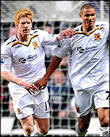 Newcastle because their black home shorts and their dark grey change shorts both clashed with the home team's. For their recent FA Cup match against the Toon, Hull brought out last season's white change kit (see left) to avoid further embarrasment. Huddersfield Town wore blue shorts and stockings recently when they visited Northampton.
Newcastle because their black home shorts and their dark grey change shorts both clashed with the home team's. For their recent FA Cup match against the Toon, Hull brought out last season's white change kit (see left) to avoid further embarrasment. Huddersfield Town wore blue shorts and stockings recently when they visited Northampton.
Falkirk (August 1962 added) - The Bairns were on the wrong end of a 9-1 hammering at the hands of Motherwell wearing these unusual halved shirts, which may explain why they reverted to plain navy that same season: Peterhead (1936 added): Forfar Athletic (1935-36 added): Caledonian (1935-36 added): Brechin City (1935-36 added).
At first glance there is nothing remarkable about this picture of Brechin City in their brand new hooped shirts 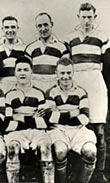 from 1935-36. Look closely, however, and you will notice that the players are wearing plain white stockings under all the mud. These were highly unusual at the time, if not unique. The prevailing styles were in dark colours with various contrasting trims and hoops were just coming into vogue. The picture perhaps illustrates the reason that pale socks were so rare: the white socks would have looked very smart in the pre-match photos but after 90 minutes on a mud-laden Scottish pitch, the effect was less than impressive.
from 1935-36. Look closely, however, and you will notice that the players are wearing plain white stockings under all the mud. These were highly unusual at the time, if not unique. The prevailing styles were in dark colours with various contrasting trims and hoops were just coming into vogue. The picture perhaps illustrates the reason that pale socks were so rare: the white socks would have looked very smart in the pre-match photos but after 90 minutes on a mud-laden Scottish pitch, the effect was less than impressive.
Aberdare Athletic (1923-24 corrected, 1924-27 added): West Bromwich Albion (1994-95, 1995-96 corrected).
14 January: We are pleased to announce the opening of our Home International Section. The complete 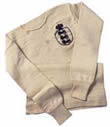 history of England's kits are now available and we will be adding galleries for Scotland, Wales, Northern Ireland and the Republic of Ireland over the next few weeks. Please take care when you enter the gallery as some paintwork may still be wet and please remember to keep children under supervision at all times.
history of England's kits are now available and we will be adding galleries for Scotland, Wales, Northern Ireland and the Republic of Ireland over the next few weeks. Please take care when you enter the gallery as some paintwork may still be wet and please remember to keep children under supervision at all times.
Most of the new material comes from the England Online Website, which includes comprehensive details of every kit and variation worn by England since 1947 and includes this image of an original England jersey from 1872.
13 January: Ipswich Town (1978-79, 1981-82 commemorative script added to badges): Bristol City (1976-78 added): Aston Villa (1974-75 change added): Liverpool (2007-08 European change kit badge now correctly positioned): Newcastle United (1980-81 added, 1978-80 stockings corrected): Liverpool (1996-97 A, 2006-07 A missing details added).
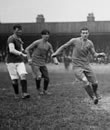 9 January: This intriguing photograph is among several updates to the Arsenal Home and Away galleries added today. Taken at Upton Park in May 1919, Arsenal are wearing what appear to be mid-blue shirts with matching knickers. (Note the contrast with West Ham's dark claret shirts and pale sky-blue sleeves). What is remarkable is that knickers were generally only available in white, black or navy blue at the time. Circumstantial evidence suggests that the Gunners were still using blue shirts as a change kit in the mid 1920s. (1918-19, 1925 change kits added, 1928-29 home kit added, 1920-28 home, 1927 FA Cup Final and 1947-53 change kits corrected).
9 January: This intriguing photograph is among several updates to the Arsenal Home and Away galleries added today. Taken at Upton Park in May 1919, Arsenal are wearing what appear to be mid-blue shirts with matching knickers. (Note the contrast with West Ham's dark claret shirts and pale sky-blue sleeves). What is remarkable is that knickers were generally only available in white, black or navy blue at the time. Circumstantial evidence suggests that the Gunners were still using blue shirts as a change kit in the mid 1920s. (1918-19, 1925 change kits added, 1928-29 home kit added, 1920-28 home, 1927 FA Cup Final and 1947-53 change kits corrected).
Shrewsbury Town (1888-89, 1922-23 added, 1907-08 badge added): Newcastle United (1919-20, 1979-80 all-white third kit added): Rangers (2002-03 change kit sponsor's logo amended): Dundee (1987-89, 1989-90, 1990-91, 1991-92, 1992-93 corrected, 1993-94 added):
We also have a few new variants of 2008-09 kits: Plymouth Argyle (alternate kit worn at Arsenal last Saturday), Kilmarnock (third kit worn at Falkirk), Rangers (white alternate change kit).
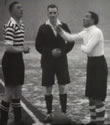 Alex James of Arsenal and Scotland was famous not only as a great pre-war player of diminutive stature, but also for his insistence on wearing the biggest shorts available. Here he is tossing the coin before the kick-off in an FA Cup tie from January 1937 against Manchester United. As required until quite recently, both teams have changed from their familiar red shirts and United are wearing a previously unknown version of their cherry and white hoops. This leads us neatly into a set of updates for United. The quality of photographs from the early twentieth century can make it hard to discern details so I am grateful to Tim Ashmore for unearthing some excellent prints that allow us to correct collar details on several early shirts and fill a few gaps. Manchester United home kits (1911-12, 1929 added; 1908-11, 1919-20, 1920-21, 1921-22, 1974-75 amended). Change kits (1936-37, 1974-75 change added; 1909 FA Cup Final badge, 1976-77 Euro, 1979-80 3rd, 1980-81 3rd, 1980-82 change all corrected).
Alex James of Arsenal and Scotland was famous not only as a great pre-war player of diminutive stature, but also for his insistence on wearing the biggest shorts available. Here he is tossing the coin before the kick-off in an FA Cup tie from January 1937 against Manchester United. As required until quite recently, both teams have changed from their familiar red shirts and United are wearing a previously unknown version of their cherry and white hoops. This leads us neatly into a set of updates for United. The quality of photographs from the early twentieth century can make it hard to discern details so I am grateful to Tim Ashmore for unearthing some excellent prints that allow us to correct collar details on several early shirts and fill a few gaps. Manchester United home kits (1911-12, 1929 added; 1908-11, 1919-20, 1920-21, 1921-22, 1974-75 amended). Change kits (1936-37, 1974-75 change added; 1909 FA Cup Final badge, 1976-77 Euro, 1979-80 3rd, 1980-81 3rd, 1980-82 change all corrected).
I've had several queries about the unbranded shirt worn by United in this match at Southampton in March 1981. Tim Ashmore has supplied the answer, which appears to be that United dug out a set of blue shirts from 1974-75 as both their red and white Adidas shirts would have clashed. For the full story click on the image but be patient as the file may take some time to download.
Exiles from Auld Reekie curious about the city's erstwhile third club, St Bernard's FC may well be interested in getting hold of George Park's St Bernard's Football Club or When the Well Ran Dry!, as mentioned on HFK on 15 December. Only 1,000 copies have been printed and until now have been available only from outlets in Edinburgh. HFK's visitors can, however, order copies by post from 15 Royal Crescent, Edinburgh, EH3 6QA for a mere £7.25 inclusive of postage & packaging (cheques payable to CCLASP). All proceeds go to charity.
7 January: Some Scottish updates, corrections and additions today. Alloa Athletic (1991-92 corrected): St Mirren (1981-82 added, 1982-83 amended): Celtic (2008-09 away kit variant added): Arbroath (2008-09 alternate all-maroon kit added): Berwick Rangers (1963-64 collar detailing corrected): Brechin City (1958-60, 1961-63 added): Caledonian (1959-60, 1962-66 added): Clackmannan (1894-95 added): Elgin City (1961-64, 1964-67, 1967-68 alternate added; the V neck 1961-62 kit is now identified as a warm weather strip 1961-67): Ferranti Thistle (1971-72 added): Inverness Thistle (1962-63, 1963-66, 1966-68 added): Leith Athletic (1891-92 added): Peterhead (1961-62, 1964-65, 1965-66, 1966-68 added): Ross County (1963-65, 1965-66, 1966-68 added): Annan Athletic (1995-96, 1996-97, 1997 Aug-Sept, Oct 1997-1998 added): Gretna (Dec 1996-98 added).
To celebrate the 50th anniversary of their best ever FA Cup run, Norwich City wore a special replica of their 1958-59 strip in their Third Round tie with Charlton at the weekend.
4 January: Happy New Year everybody!
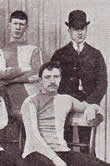 Let's start 2009 with a few updates: Arsenal (1918-29 change kit added): Shrewsbury Town (1986-87 centenary kit added): Clyde (new 2008-09 third kit): Cowdenbeath (1989-90 added): Forfar Athletic (1996-1998 added).
Let's start 2009 with a few updates: Arsenal (1918-29 change kit added): Shrewsbury Town (1986-87 centenary kit added): Clyde (new 2008-09 third kit): Cowdenbeath (1989-90 added): Forfar Athletic (1996-1998 added).
Raith Rovers' 125 Group have set up an excellent website to celebrate the club's 125th anniversary from which we've been able to make some interesting additions and corrections: (1889, 1890, 1891-92, 1903-04, 1906-17, 1921-22, 1953-54 added: 1893-1900, 1959-60, 1988-90, 1989-90, 1990-91 amended). The picture on the left is one of the many early team groups featured on the site and shows the Raith team from 1887 wearing the halved shirts that inspired this season's anniversary kit.
If you own a copy of Sunderland's 1988-91 Hummel home shirt please get in touch.
